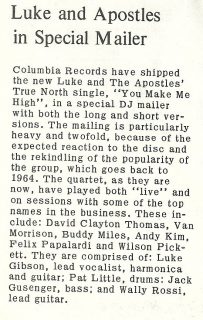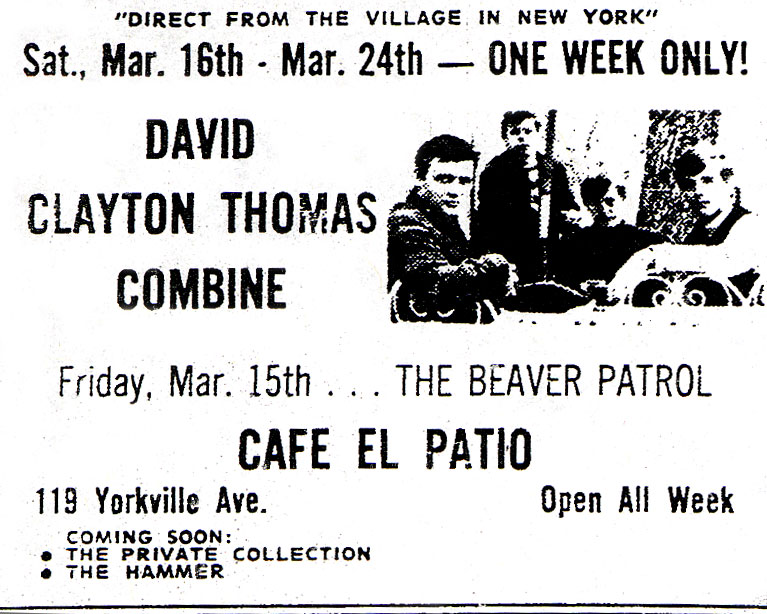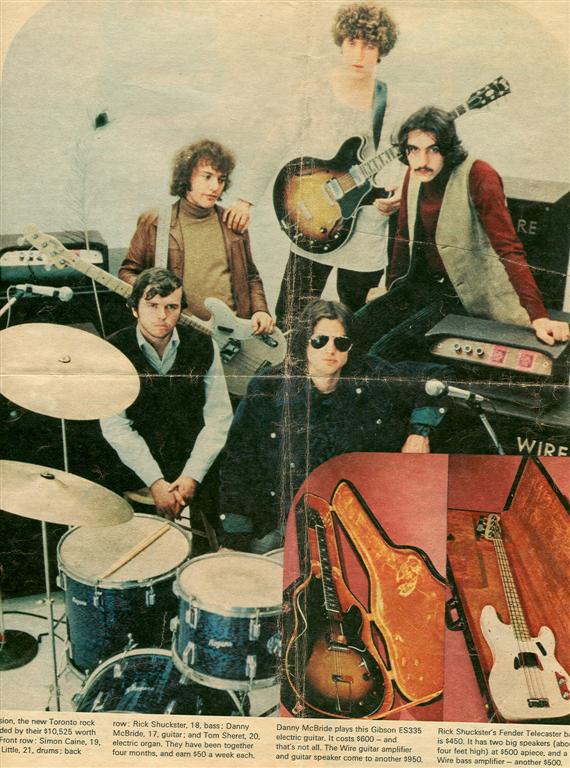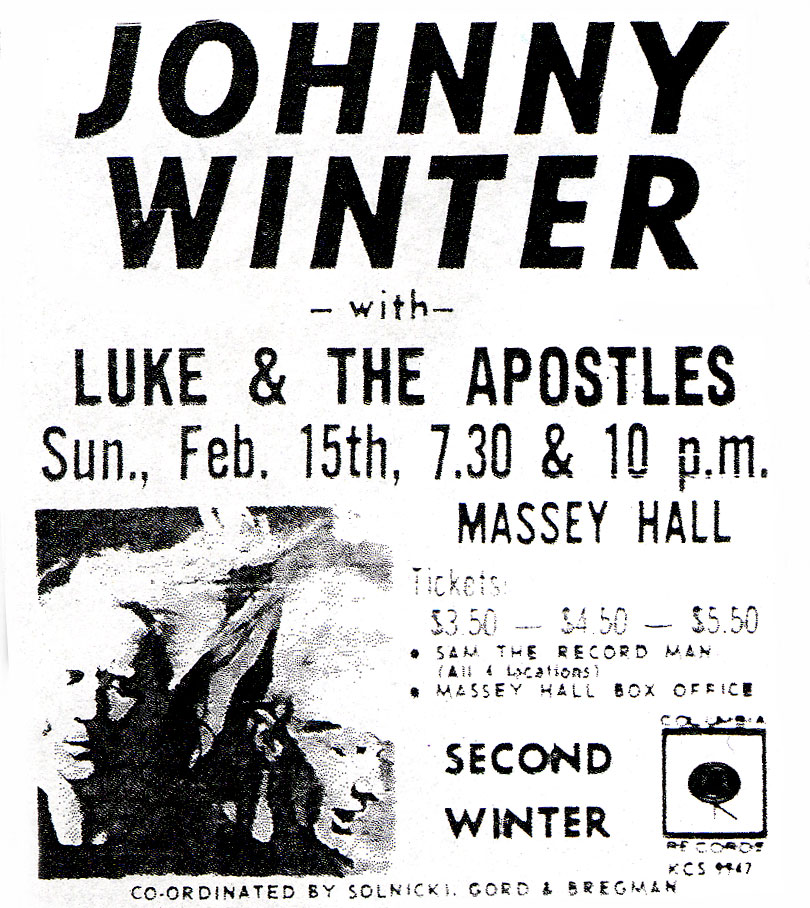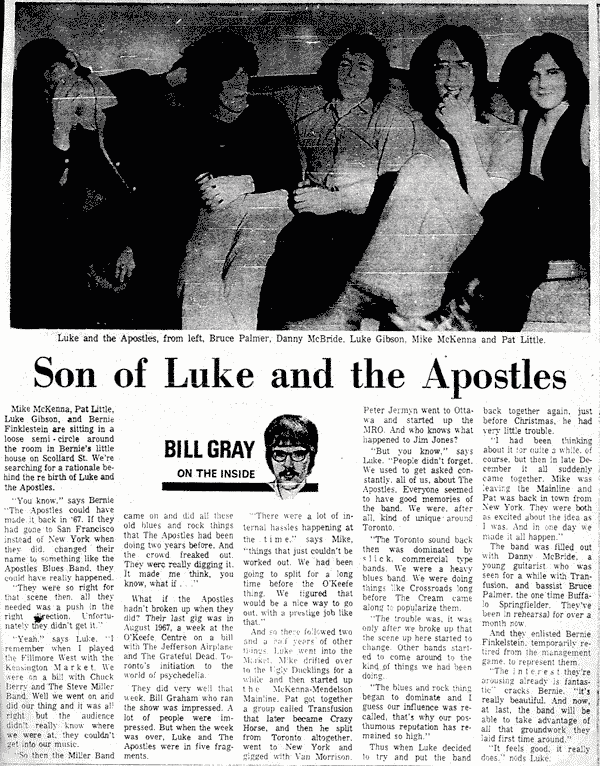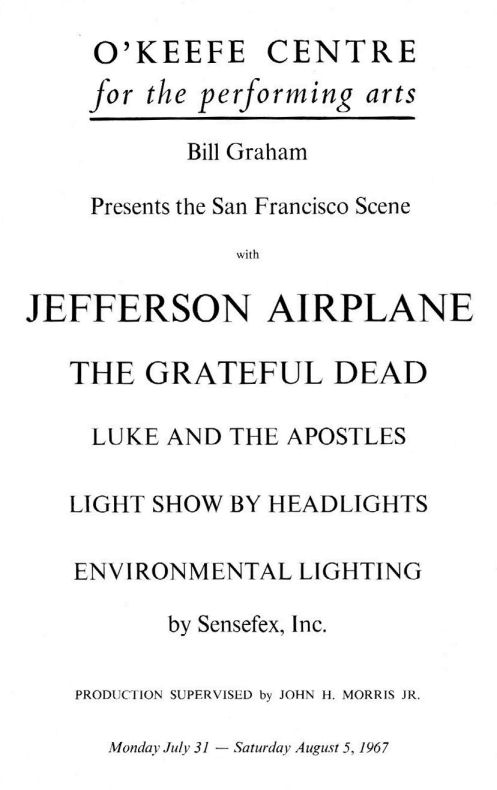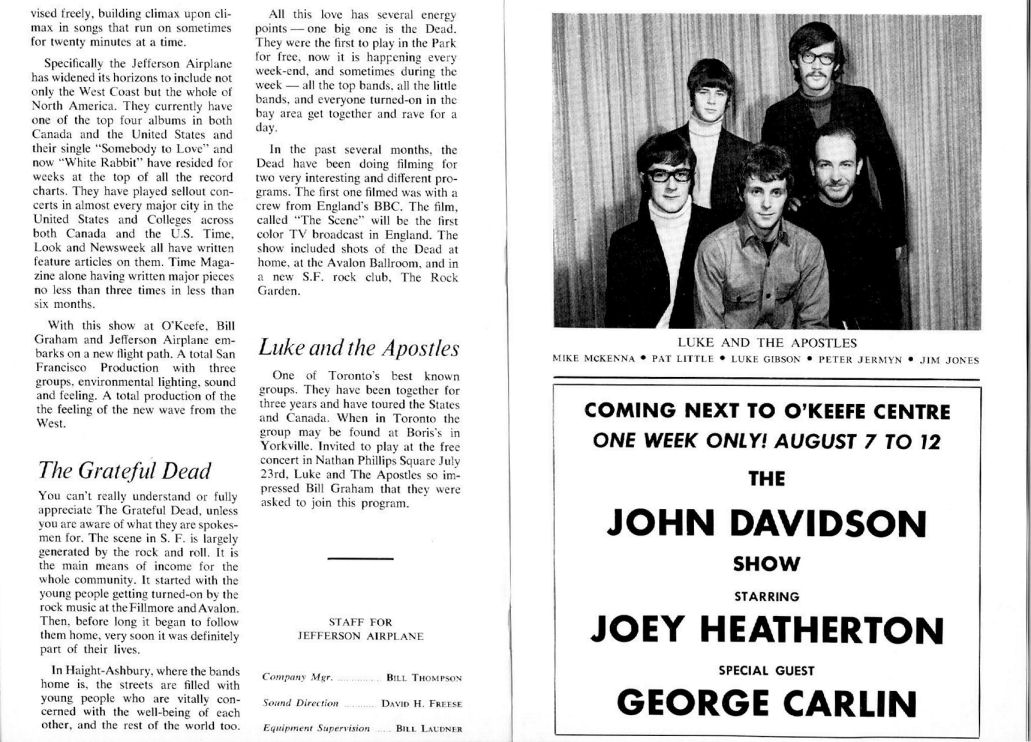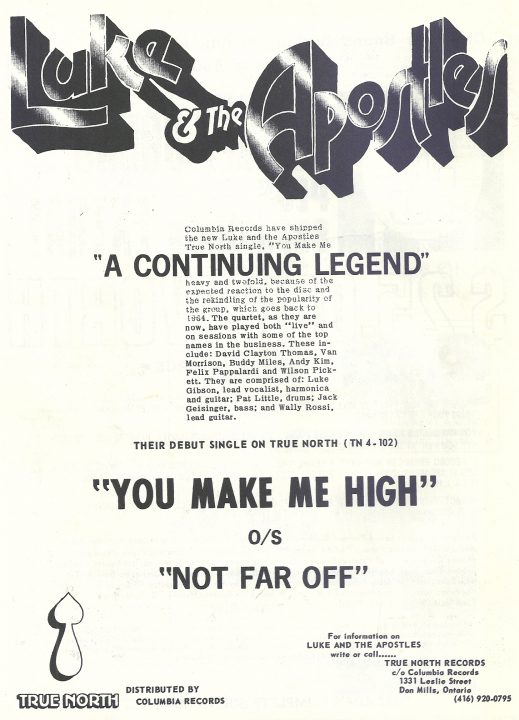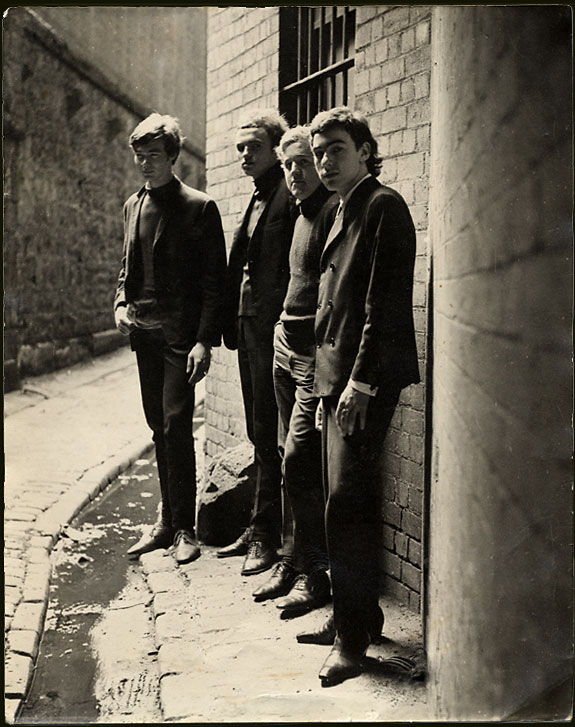
Isolated geographically in the southern Pacific Ocean, Australian rock musicians may as well have been plying their trade on another planet as far as North American, British and European audiences were concerned. Indeed, in terms of rock music per se, only the Bee Gees (who were primarily pop) and the Easybeats made any headway internationally, and only then once they’d relocated to the mother country.
Yet despite its vast distance from the all-important American and British markets, Australia gave birth to vibrant music scenes that delved deep into beat, R&B, punk and psychedelia. Many of the recordings from this period have found their way on to compilations over the years, most notably Raven Records’ superb Ugly Things aand the noteworthy Sixties Downunder series. Thanks to the dedicated and exhaustive work of respected Australian music archivist Glenn A Baker, mastermind behind Raven Records, these priceless gems have provided a handy introduction to Oz legends like the Missing Links, the Purple Hearts and the Master’s Apprentices.
Less celebrated than many of their Australian contemporaries but arguably more significant in the creative stakes was Melbourne’s Wild Cherries. Where most Oz bands during those halcyon days blatantly wore their influences on their sleeves, the Wild Cherries were uniquely original and uncompromising in their delivery and execution. “Exciting, revolutionary excursions into a musical void with no concessions to commercial demands” is how Australian rock journalist Ian McFarlane describes the band’s music in his superb Encyclopedia of Australian Rock and Pop.
Given that the Wild Cherries contained Australia’s first guitar hero, Lobby Loyde, it’s perhaps not surprising that they are revered by many as such a pivotal band. Apparently a significant influence on such notables as Kurt Cobain, Pavement’s Stephen Malkmus and Henry Rollins, Loyde took the guitar in to uncharted territory on the Australian rock music landscape.
And yet if the truth be told, the Wild Cherries’ real strength lay in the sum of its individual parts, which gave the band an enviable power and kudos. If there’s anyone who deserves credit for being the underlying creative force in the Wild Cherries though, it’s undoubtedly founding member, Les Gilbert (b. 10 January 1946, Melbourne, Australia), today a successful composer and leading exponent of sound and multimedia installations. Perhaps more than anything, it was Gilbert’s interest in sound that enabled the Wild Cherries to delve headlong into their innovative and uncompromising musical excursions.
Having studied classical piano with noted pianist Leslie Miers from the age of six and playing in competitions across the city, Gilbert later became a modern jazz enthusiast, although he never got to play in any bands. Says Gilbert: “I briefly contemplated a career in classical music but became much more interested in art and wanted to become a painter. When I won a scholarship to university I studied architecture because I thought it would further my training as an artist. I dropped out of university after two and a bit years to play in the Wild Cherries as a full-time occupation.”
Gilbert formed the original Wild Cherries sometime in late 1964/early 1965 with several friends from the architecture school at Melbourne University. The founding members of the group comprised John Bastow on vocals and harmonica and Rob Lovett (b. 11 November 1944, Melbourne, Australia) on rhythm guitar and vocals. Interestingly, while he was primarily a pianist, Gilbert initially played bass.
“To start the band, we didn’t really have any equipment,” says Gilbert. “Rob Lovett had his own guitar and a 15-watt Goldentone amplifier. I had made a bass guitar from a broken cello. I had cut the cello down with a saw and glued it back together with a bass guitar neck made by a carpenter friend of my father’s. I found some electric pickups and bass guitar strings in a music shop.”
With the nucleus of the group complete, the musicians started to discuss a suitable moniker for the band. “The name ‘Wild Cherries’ came from an afternoon when we were rehearsing in my bedroom and we were bandying names around,” says Gilbert. “It came from a word game with a corruption of Chuck Berry, which became Buck Cherry, which became Black Cherries, which became Wild Cherries.”
Soon afterwards, Malcolm McGee (b. 1 November 1945, Melbourne, Australia) was added to the line up on lead guitar and vocals. “Malcolm was from the blues scene and had been playing acoustic guitar and singing blues in folk music venues,” says Gilbert. “He made the transition to electric guitar pretty effortlessly. The original drummer came from the medical school at the university, although he didn’t actually make a public performance.”
From the outset, Gilbert was the motivating force in the Wild Cherries and was instrumental in putting together the amplification for the rest of the band. “Another friend of my father’s was a radio engineer and he built me a 30-watt valve amplifier with four input channels,” remembers Gilbert. “I made two speaker boxes, each with a 12” speaker. We somehow found a couple of microphones and we were ready. This one amp with two speakers was for the mics, bass and lead guitar with a speaker box on either side of the stage – and people thought we were loud!”
The Wild Cherries’ debut performance took place at Melbourne’s first discotheque, the Fat Black Pussycat, which was located in Toorak Road, in the South Yarra district. During the ‘50s and early ‘60s, Melbourne had enjoyed a vibrant jazz scene but by early 1965, this scene was in steady decline. Says Gilbert: “The Fat Black Pussycat had been a jazz venue and was run by an American guy called Ali Sugarman – very much along the lines of a New York jazz club. With declining audiences he decided to change the music to stay in business and for some reason I can’t really remember, we were asked to perform the first night of its conversion from jazz to…I struggle with finding a word for what we called our music at the time. We didn’t think of it as ‘rock’ or ‘pop’. We were more serious than that – probably thought of it as ‘electric blues’.”
On the night of the band’s big performance, the musicians turned up only to learn that the drummer was absent. “His mother wouldn’t let him come, so we had to play the whole night without drums,” explains Gilbert. “John Bastow furiously shook maracas and banged a tambourine. Our repertoire came from a mixture of old blues songs, Bo Diddley, Chuck Berry, etc and we probably knew about a dozen songs we could play – which we just kept repeating for the night. We were the only band. There weren’t many around.”
Despite the drummer’s absence, the evening was a great success and the band was asked to play at the club for five nights a week. In a fortuitous turn of events, the group found a replacement drummer straight away. “Kevin Murphy had been playing in a modern jazz trio which now didn’t have any work and he joined us,” says Gilbert. “He was a big man with an incredibly powerful technique. He sat very low and used huge drumsticks. Totally out of the ordinary at the time, although it soon became the norm. We expanded the repertoire and very often featured extended solos for all of us – straight out of the modern jazz tradition. Songs would involve a lot of improvisation and would last up to 20 minutes – Kevin Murphy’s drum solos would sometimes go on for 20 minutes on their own!”
The new line up soon got the opportunity to record, albeit crudely, when Gilbert’s friend Lloyd Carrick recorded the band’s rendition of Manfred Mann’s “Without You” in his parents’ sitting room on a 1/4” Tandberg recorder! John Bastow was absent on this occasion and it was left to Malcolm McGee to provide the song’s gutsy lead vocal.
As multi-talented as it was however, a group comprised of such disparate personalities and musical tastes was never likely to have much longevity and in October 1965, Rob Lovett accepted an offer to join the newly formed Loved Ones, fronted by the incomparable Gerry Humphreys.
Reduced to a quartet, the Wild Cherries continued to perform regularly at the Fat Black Pussycat. On one occasion, possibly during a rehearsal or after hours, Gilbert can’t remember exactly, three tracks: a cover of J D Loudermilk’s “Tobacco Road” and two blues standards, “Worried Blues” and “You Don’t’ Love Me” were recorded by Carrick. Using only a simple four-channel mixer and a Tandberg reel-to-reel tape deck to record the tracks, the three songs provide a fascinating insight into the early group’s raw energy.
A short while later however, Kevin Murphy also departed for pastures new, later joining Billy Thorpe’s seminal band, the Aztecs; his vacant drum chair filled by Keith Barber (b. 17 April 1947, Kilburn, Middlesex, England).
Barber, whose family had migrated to Melbourne around Christmas, 1958, took up drums at the age of 17 after visiting the Fat Black Pussycat. Inspired by the jazz players, Barber bought a drum kit, urged on by another musician at the printing school where he had begun his apprenticeship. Having learnt the basics, Barber, abetted by the other musician, performed at the printing school’s apprentice of the year award and, to their surprise, the pair were favourably received and both won awards.
As Barber recalls, his entry into the Wild Cherries was largely fortuitous: “I was with my mates who appreciated modern jazz and we had a flat in Chapel Street in Prahran, a Chelsea-type district in Melbourne. Les, Malcolm and John must have been walking past and heard me playing and they came in and asked me if I’d like to join.”
At Barber’s instigation, the group started to become more style conscious and the whole band had double-breasted suits tailored to wear on stage. Around the same time, the Wild Cherries were presented with an opportunity to record a couple of tracks for a prospective single.
The recordings comprised an original composition entitled, “Get out of My Life” coupled with a cover of Sonny Boy Williamson’s “Bye Bye Bird”, which had recently appeared on the Moody Blues’ Magnificent Moodies album. For some inexplicable reason, no one picked up on these fine recordings and tracks remained unreleased – until 2007.
On 19 February 1966, the group made its final appearance at the Fat Black Pussycat. Lloyd Carrick was again on hand to record the gig. By now he was using a Nagra recorder with professional quality mics and a mixer. The recording resurfaced in December 2006 and appears on Half A Cow’s CD compilation (more of which later).
By June 1966 however, the original Wild Cherries had pretty much run their natural course. “The group got to play places like the Thumpin’ Tum and the Fat Black Pussycat, which was our dream,” says Barber but “the next thing was it drifted into this sort of half awake sort of life where nothing happened and I think Les got ill. Malcolm moved on to become lead singer in Python Lee Jackson and John, I think, decided to reinvestigate his academic career.”
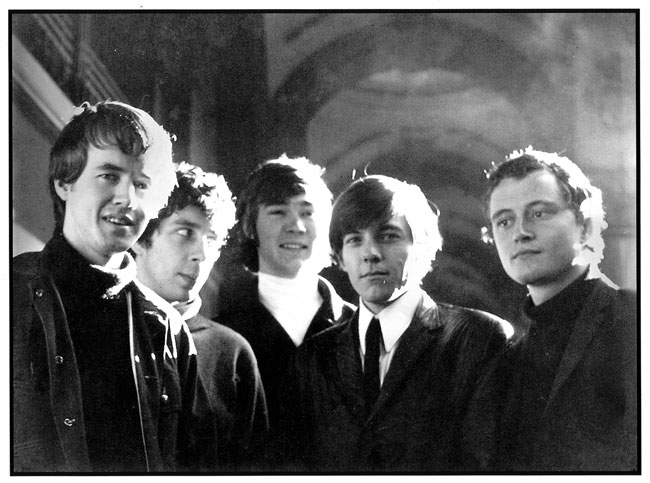
Adds Gilbert: “I had bought a little Italian electric piano and this led me to have ambitions for a Hammond organ. Somehow I managed to buy one and I now switched instruments.”
The decision to buy a Hammond had coincided with a Bob Dylan concert that Barber and Gilbert had attended back in April. This pivotal event, explains Barber, was to have a significant bearing on the Wild Cherries’ future musical direction. “We were looking up on stage and we saw this Leslie speaker. Les went home and built one and turned up with it at rehearsal four days later. You can actually hear it on the [Festival] recordings. It’s not the full Leslie effect; it doesn’t have the attack. Les Gilbert’s Leslie. We used to call it the ‘fairy floss machine’.”
Having weathered the loss of Bastow and McGee, and keen to re-establish the band with a more contemporary blues-rock approach, Gilbert and Barber began the task of recruiting a new singer. Soon enough they found their perfect front man in former Weird Mob bass player and vocalist Danny Robinson (b. 15 March 1947, Warrnambool, Victoria, Australia).
Blessed with a fabulous soulful voice that displayed tremendous power and drive, Robinson had begun his career in the early ‘60s playing urban blues at folk clubs in Melbourne, where he mixed solo spots with dates that he performed with friends. In the summer of 1966, Robinson accepted an offer to join the final incarnation of the Weird Mob on bass, which is where he befriended lead guitarist, Peter Eddey (b. 11 August 1947, Melbourne, Australia).
Unlike Robinson, Eddey had not been active on the local scene for very long. Even so, he had been playing music for a number of years, having first learnt the piano at the age of eight. Six years later, Eddey took up the guitar and at high school played lead guitar in several bands. His first notable outing however, was the Weird Mob, which he formed with some school friends.
The band had already been through several incarnations by the time Robinson joined and, as Eddey recalls, the singer immediately made his presence felt: “We played the local suburban venues, and with Dan we moved into a kind of Motown, bluesy feel. Dan had a great voice.”
According to Eddey, Robinson was one of a handful of musicians that were approached to audition for the new version of the Wild Cherries. Eddey was next to join the fledging line up, but as he readily admits, his inclusion was guided more by practical considerations. “They didn’t have a bass player in mind, so I went with Dan and played bass for the first time. They really wanted Dan and I happened to be Dan’s friend who could get by on bass – that’s how I came to be in the group.”
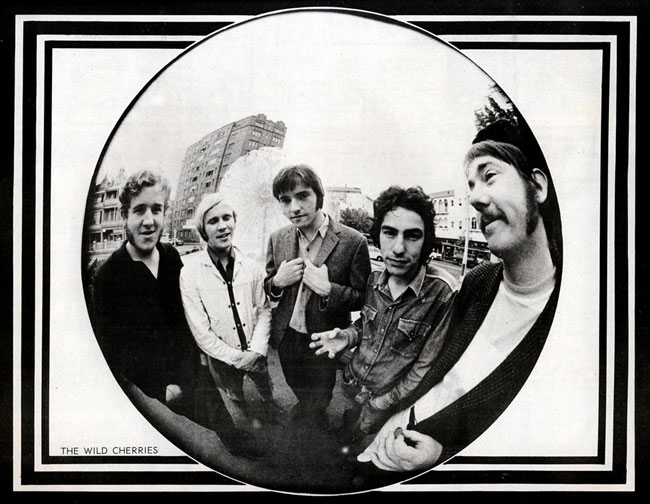
The new line up then spent several months rehearsing while looking for a suitable guitar player. In January 1967, the final piece fell into place with the addition of recently departed Purple Hearts guitarist Lobby Loyde (b. John Baslington Lyde, 18 May 1941, Longreach, Queensland, Australia).
Having studied classical piano as a child, Loyde took up the electric guitar during his late teens. Says Loyde: “I guess I had been playing six weeks when I joined Errol Romain and the Remains. I learnt the guitar by ear. I didn’t sit down and learn the damn thing… a la translating what I knew on the piano to the guitar because that’s not what I wanted to play anyway. I wanted to play rock ‘n’ roll and to play rock ‘n’ roll you had to learn on the job because it was a new music.”
From the Remains, Loyde moved onto another instrumental band, Bobby Sharpe and the Stilettos, who, like his previous outfit, were heavily influenced by Cliff Richard and the Shadows. As Loyde points out, however, “I was also playing in other bands at the time. I was playing in the blues clubs playing dobro and acoustic with any blues player I could get my hands on. That’s why I jumped at the chance to the join the Purple Hearts who were then called the Impacts. It was my kind of band. They had a really rich flavour to their blues and went at it from their own angle.”
Like the Bee Gees and the Easybeats, Brisbane’s finest exponents of R&B, the ferocious Purple Hearts were largely comprised of expatriate Brits. Singer Mick Hadley and bass player Bob Dames had both witnessed the burgeoning R&B scene in London before emigrating in the early ‘60s, while latter-day drummer (and future Easybeat) Tony Cahill, had briefly beaten the skins for Screaming Lord Sutch.
Barber, in particular, remembers vividly the devastating impact the Purple Hearts had on the local scene when they first arrived from Brisbane. “When the Purple Hearts came down from Queensland and hit Melbourne practically every band realised, ‘shit, we can’t play, these guys can play’. They were very, very good. They were the real thing, a travelling band.”
The powerhouse in the Purple Hearts, however, was undoubtedly the band’s lone Australian, Lobby Loyde. Loyde’s incisive, incendiary playing propelled such Purple Hearts classics as “Of Hopes and Dreams and Tombstones” and “Early in the Morning”, but by early 1967, Loyde was looking for a more experimental outlet for his increasingly wild and innovative style. “While the Purple Hearts were a great band to play with…when you start to lose that edge and energy thing and… I felt it was time to move on,” says Loyde.
While everyone was obviously in awe of Loyde’s playing, according to Eddey, Loyde was equally knocked out by Danny and Les, and immediately jumped at the chance to complete the line up. The group desperately needed somewhere to rehearse their act and soon stumbled across an old property in south Melbourne that had no power or hot water. “Myself and Lobby had nowhere to live so we lived there,” remembers Barber. “We used to hose each other down in the backyard with an old kitchen oven turned on its side, full of paper, with copper pipes through it, and run the water through that way so that it wasn’t freezing. We lived and rehearsed in that house for three months before we put that version of the band on the road.”
Initially, the Wild Cherries played the blues with a peppering of soul covers (Wilson Pickett, Otis Redding, Solomon Burke) and then adopted a heavier approach, incorporating Graham Bond and Jimi Hendrix-type material with some psychedelic undercurrents. “We were on the edge I think – well ahead of most other bands at the time,” claims Eddey, “but then we had some seriously good musicians in Les and Lobby.”
Within a month of Loyde’s arrival, the group aroused the interest of Stan Rofe, the local DJ king on 3KZ, one of the city’s radio stations. Impressed by the band’s originality and verve, he approached Festival Records and convinced the label to sign the band to a record deal. As Loyde notes however, despite signing with the label in Melbourne, where there were four-track facilities, Festival insisted that the band should record all of its material in Sydney on mono equipment. (Gilbert remembers things somewhat differently and says that the recording studio in Sydney was four track!)
Before any recordings commenced, the label booked a weeklong stand at Here disco in North Sydney during early February where the group covered for absent local group, Jeff St John & the Id. During their initial foray into the Sydney rock scene, harp player Shayne Duckham joined the group on stage for a couple of shows. Recalls Robinson: “I first ran into Shayne when I began drinking at the local Push pub in Melbourne back in 1963. He was an interesting bohemian character who played very good blues harmonica and was a bit of a guru. He never got into a recording situation, but you’ll find a hell of a lot of musicians out there that would claim to have been steered in the right direction by Shayne. He would arrive on the doorstep and hand you a whole clutch of 45s that you’d never heard of but they would turn out to be totally seminal material. He ended up getting stabbed to death on a prawn boat around 1982.”
Despite their short time together, the Wild Cherries made an instant impression on the local scene. Writing in the Sydney Morning Herald in late February, under its Pop Scene section, Craig McGregor raved about the band, which he dubbed “Wild Indian Cherries”. “What makes the group so distinctive is its loose, underivative, free-flowing style, which often seems close to jazz in approach, though the sound is in the usual pop-soul idiom,” remarked McGregor. “Like a good jazz group, the Wild Cherries improvise all the time and they can subtly alter the focus of the music from chorus to chorus; they are one of the few groups which have got something going all the time and retain the capacity to surprise.”
McGregor singled out Loyde’s playing, observing that he had “absorbed more of Indian classical music into his phrasing and melodic ideas than any other pop guitarist I know.” McGregor went on to applaud Loyde’s authenticity, exclaiming: “Loyde seems to have mastered the idiom so well it has become part of his natural style, and on his own, ‘Sitar Blues’ he can take off on a wailing 10-minute improvisation which would make the hair of many a raga-conscious jazz musician stand on end!”
While journalists were knocked out by the band’s performance, Festival really didn’t know what to make of the band. When representatives from the label attended the band’s shows, they were in for a shock, as Loyde recalls: “We went up and played a gig and they came and listened and went, ‘Whoa, Jesus, none of that is recordable’ – they thought it was pretty crazy stuff. We went back to Melbourne and sat down and had a bit of a write around, and next time we went back we had some tunes they could cope with.”
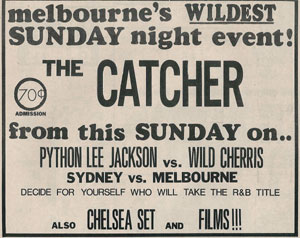
Back home in Melbourne, the group started picking up regular gigs on the local club scene, debuting at the Catcher in mid-February. Later that month, the group appeared at the Biting Eye on 25 February and the following night, appeared at the Thumpin’ Tum.
The group returned to the Catcher on 4 March for a show alongside the Clefs, Mind Excursions and the Chelsea Set. The following week, on 8-9 March, the group held down a two-night stand at Sebastians and then, a few days later, the Wild Cherries returned to the Catcher on 12 March for a show with the Loved Ones, the Chants, the Chelsea Set and the Adderly Smith Blues Band.
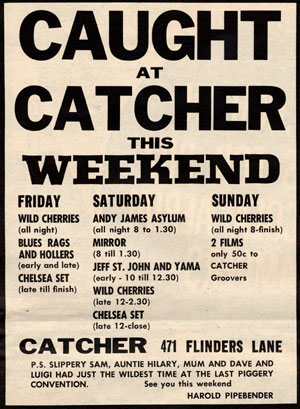
Returning to Sydney in April for an extended engagement at Here disco, the group once again drew a positive reception from the press. Teen magazine, Go-Set, published a beaming piece about the group under the intriguing header, “Wild Cherries – Filling the gap left by the Easys?” Claiming that the pop scene was full of surprises, journalist Wal McCall exclaimed, the “…biggest surprise to me, and to anyone who has ever heard the Cherries, is that they’re not the biggest name group in Australia.”
Reviewing the Wild Cherries’ return to Here disco, Go-Set marvelled at their undoubted talent: “…when the new Cherries formed back in February they were more than just very good…But now, only two months later, their progress both musically and as entertainers has to be seen to be believed.”
Comparing Dan Robinson to local singer Jeff St. John, Go-Set praised his singing commenting “[Robinson] is one of the few singers around capable of singing as well as St. John. Their styles in some ways are similar, but Danny, like Jeff, has his own highly personal style of vocal dynamics. His ability to get the best out of good songs marks him down as a member of the magic circle of bluesy singers.”
Like the Sydney Morning Herald, Go-Set also heaped praise on Loyde’s playing, stating: “He’s the type of guitarist that is easily recognised by true blues and R&B fans as outstanding. He plays like Bloomfield and Clapton, but even that’s not completely true – he plays like Lobby Loyde and his long, wailing notes give the Wild Cherries a lot of guts.”
Go-Setwas not the only Sydney publication to recognise the Wild Cherries undoubted potential. In an unaccredited article entitled, “the Wild Cherries – the Id challenged”, the unnamed author describes the band’s performance as “an overpowering experience”, adding, “the Id will certainly need to put on their best to keep up the standard!”
As with other reviews from this period, the piece singles out Robinson and Loyde’s contributions. Particular praise however, is saved for Les Gilbert. “Les plays excellent organ but, unlike a lot of organ players, does not try to dominate the whole group. The group drives all the more because of this.” Concluding, the author says the band should prove to be a great force in the future. “It is not often that, at the finish of a number, the audience just stands and cheers, particularly in Sydney’s more sophisticated licensed discotheques.”
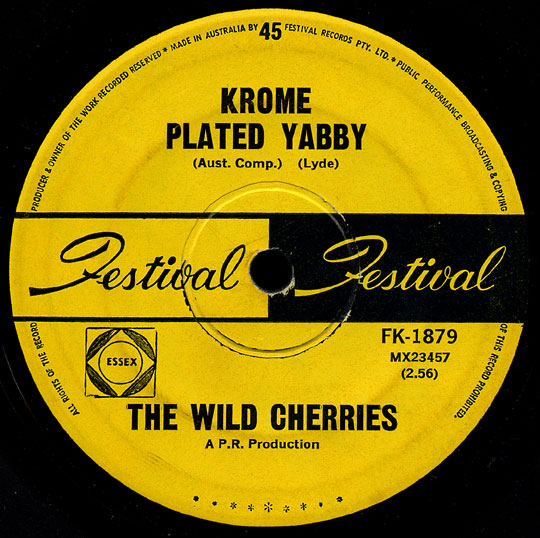 While playing Here disco in April, the Wild Cherries entered Festival’s studios and laid down several tracks for a prospective single. Three completed tracks were nailed in the session, all Lobby Loyde compositions. These comprised the soul-inflected ballads, “Try Me (I’m Not As Bad As You Think)”, and “Everything I Do Is Wrong” (which graced the b-side of the Wild Cherries’ debut 45), and the single’s a-side, the curiously titled “Krome Plated Yabby”, which has a slight Move influence. (In an interesting side note, Barber says the group also recorded a demo of Otis Redding’s “Fa-Fa-Fa” at the first session, but it was never completed.)
While playing Here disco in April, the Wild Cherries entered Festival’s studios and laid down several tracks for a prospective single. Three completed tracks were nailed in the session, all Lobby Loyde compositions. These comprised the soul-inflected ballads, “Try Me (I’m Not As Bad As You Think)”, and “Everything I Do Is Wrong” (which graced the b-side of the Wild Cherries’ debut 45), and the single’s a-side, the curiously titled “Krome Plated Yabby”, which has a slight Move influence. (In an interesting side note, Barber says the group also recorded a demo of Otis Redding’s “Fa-Fa-Fa” at the first session, but it was never completed.)
Recalling the session, Loyde says: “The engineer that recorded that stuff was dressed in a suit with short back and sides. He kind of looked like a cost clerk for Dunlop rubber; he certainly didn’t expect to go down and sit at the desk and be creative because to be creative wasn’t in this guy’s agenda. He questioned everything. But the producer, Pat Aulton, was interesting because he was a singer, so he kind of got into it. He ended up taking over the engineering himself and threw the engineer out in the end. While some of the records sound a bit hollow at least he was a music enthusiast and at least he tried really hard to capture what we were doing. Because it was mono, we had to record it live and that was a challenge.” (Pat Aulton, incidentally sang harmony on “Everything I Do Is Wrong”.)
Loyde continues: “In those days recording mediums weren’t that portable, so there was very little live material being done in Australia. When everyone in England was using four track we were still in mono and then when everyone in England went on to eight and 16 track we got four track. It was old technology, half the decks were home made and recording was quite primitive. And the Australian recording industry never took itself professionally and never had much respect for the local stuff. It was a very strong live scene but a very poor recording scene.”
While Loyde claims his songwriting was somewhat influenced by the San Francisco acid rock scene, he also maintains that the band was a bit insular and a lot of his ideas stemmed from listening to the group itself. Indeed, with Robinson’s penchant for soul music, the Wild Cherries’ were able to stretch out artistically into several directions. Says Loyde: “As well as a psychedelic edge, we had a sort of poppy psychedelic edge. And as you can tell by the flip side, the lead singer always wanted to be Otis Redding anyway. That’s why I used to write soul songs for him.”
As for the single’s oddly titled a-side that, according to Loyde, was the soundman’s idea. “He was pretty psychedelically enhanced and our producer turned to him and said, ‘What would you call this song?’ and he said, ‘It sounds like a Krome Plated Yabby to me, man!’. We thought, why not?”
Gilbert has a different take on events: “I thought the title came in a free-flowing conversation with our roadie, Mark Allenson – as a deliberate attempt at an ‘Australianisation’ of the Ken Kesey acid scene, but I might be wrong.”
“Krome Plated Yabby” was duly issued in June 1967 but failed to make any headway on the local charts. Considering the single’s advanced nature, this was perhaps not very surprising. As Australian music journalist Paul Culnane, points out: “Driven by Lloyd’s [sic] feedback guitar pyrotechnics and the evil vocal inflections of Robinson, this emotive and dynamic tune sounded like nothing else on the airwaves during ’67…”
That’s undeniably true. Artistically and creatively speaking, the Wild Cherries were incomparable as a live act and this was the underlying problem when it came to achieving commercial success. Everyone in the band was writing material (much of it highly ambitious) and, as Loyde readily admits, it was practical considerations that resulted in his compositions being recorded for potential singles.
“It was a time constraint. We had to go up to Sydney and knock up a couple of singles and I had written some tunes that were purposely written to be singles. The guys played them a few times and we kind of knew it. But if we’d gone on to make an album, we would have heard a whole pile of different flavours. Some of the stuff that went unrecorded was bloody mighty. But there was no way we were going to cut some of the great stuff down from six or seven minutes to a three-minute single.”
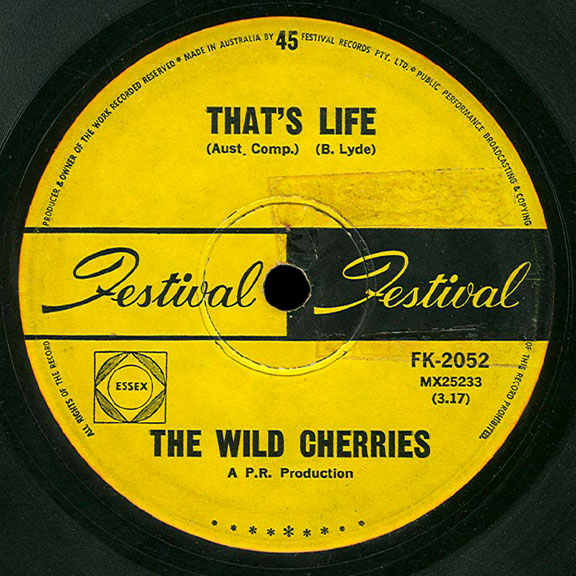 Undeterred by “Krome Plated Yabby”’s failure to bother the charts, the Wild Cherries returned to Sydney to record a fresh batch of material in the summer. At the second session, they recorded two more Loyde compositions: the phase-drenched rave up, “That’s Life”, and the soul-flavoured ballad, “Time Killer”.
Undeterred by “Krome Plated Yabby”’s failure to bother the charts, the Wild Cherries returned to Sydney to record a fresh batch of material in the summer. At the second session, they recorded two more Loyde compositions: the phase-drenched rave up, “That’s Life”, and the soul-flavoured ballad, “Time Killer”.
The recordings complete, the Wild Cherries returned to Melbourne, where they continued to draw a fanatical following, performing regularly at such venues as the Thumpin’ Tum, Sebastians, Berties and the Catcher. “There was so much live music happening in Melbourne,” says Robinson, “that all of the bands that ever had anything going for them pretty much had full-time employment. When we had a record out, we’d do up to five gigs on a Saturday night. We’d do a spot at each of three suburban dances, with perhaps a couple thousand kids at them and then we’d go do a midnight show at the Thumpin’ Tum and then a 3 am show at the Catcher.”
“The music in the underground scene was very, very interesting,” adds Loyde. “People were playing for the right reasons because there was no bucks in it and playing because they loved it. Gigs tended to be long drawn out things. We used to play from eight at night to two in the morning.”
When the band wasn’t gigging incessantly on the local scene, it also managed to travel as far a field as Brisbane and Adelaide to play a few dates. Unfortunately, unlike many of their Australian contemporaries, the Wild Cherries never got the opportunity to do a national tour.
The Wild Cherries’ uncompromising approach to their music did hurt the band in some areas. Although the press had been largely supportive, the group found dealing with the television stations more problematic, particularly as the members were never really interested in miming. “We always insisted on playing live which really pissed off the guys at TV stations, and Lobby can’t put a guitar around his neck without a cigarette in his mouth,” chuckles Barber.
“We did one performance, the excerpt from the ‘Carnival of the Animals’ by Saint-Saens that directly relates to the elephant with Danny playing double bass. Lobby actually had his head in my bass drum with smoke coming out and they told us to cut, and we wouldn’t cut and went into something else, so our TV career was blighted so to speak.”
TV career or no TV career, the Wild Cherries continued to impress artistically. Festival duly issued the band’s second 45, “That’s Life” c/w “Try Me (I’m Not As Bad As You Think)” in November 1967. One of the most adventurous singles to emerge on the Australian charts during the ‘60s, it somewhat surprisingly became a minor hit on the Melbourne chart, peaking at #38.
By the time “That’s Life” appeared however, Peter Eddey had left the band; his place filled by John Phillips from rival Melbourne group, the Running Jumping Standing Still. As Eddey recalls: “I decided to leave and move to Sydney in late 1967. I was very young at the time…had a lot of pressure on me from my family, and got called up for Vietnam. Anyway, I went to university and did not have to go to Nam. I have been in the education business ever since.”
With John Phillips’ arrival, the Wild Cherries undoubtedly stepped up a gear musically. Besides his dexterity on the bass, it also didn’t hurt that the newcomer was working with an Australian amplifier and speaker company during the day.
Throughout December, the new line up played regularly on the Melbourne scene, appearing at the Catcher on 1-2 December with a number of local groups, including the James Taylor Move and the Groove. A few weeks later, the group returned to the club for three all nighter and early morning shows on 15-17 December.
On a more important note, the Wild Cherries participated in the Velodrome concert, held in Melbourne’s Olympic Park with the Twilights, Lynne Randell, the Groop, the Groove, Jeff St John & the Yama and many others on 17 December. Then, early in the new year, the group returned to Sydney to complete a new single and fulfil a handful of local dates.
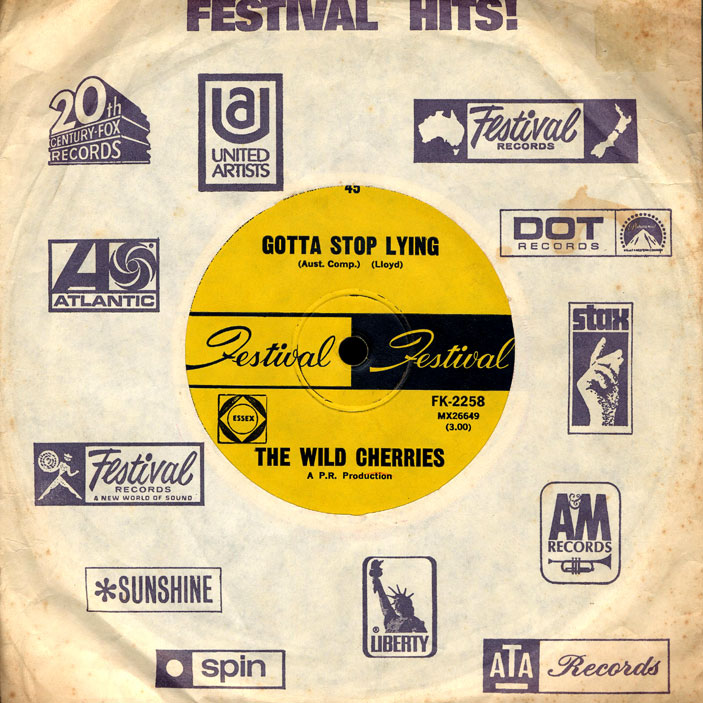 Coming up with a worthy successor to “That’s Life” was never going to be easy, but the Wild Cherries pulled out all the stops with the marvellous “Gotta Stop Lying” c/w “Time Killer”, issued in April 1968. Propelled by a kick-ass rhythm; ignited by piercing stabs of incendiary guitar, which culminated in a gut wrenching guitar solo, and topped off by Robinson’s intense, pleading vocals, “Gotta Stop Lying” was (as far as this listener is concerned) the Wild Cherries’ finest outing on disc.“Gotta Stop Lying” was also another advance in sound for the Wild Cherries and is notable for a rather unusual drum effect. Says Barber: “What it was, was an intricate bass drum pattern that somehow has got a click on it.”
Coming up with a worthy successor to “That’s Life” was never going to be easy, but the Wild Cherries pulled out all the stops with the marvellous “Gotta Stop Lying” c/w “Time Killer”, issued in April 1968. Propelled by a kick-ass rhythm; ignited by piercing stabs of incendiary guitar, which culminated in a gut wrenching guitar solo, and topped off by Robinson’s intense, pleading vocals, “Gotta Stop Lying” was (as far as this listener is concerned) the Wild Cherries’ finest outing on disc.“Gotta Stop Lying” was also another advance in sound for the Wild Cherries and is notable for a rather unusual drum effect. Says Barber: “What it was, was an intricate bass drum pattern that somehow has got a click on it.”
The flip side, meanwhile, like its predecessors, stood in stark contrast to the a-side and continued the tradition of Wild Cherries singles by treading a soul path. Interestingly, according to Loyde, “Gotta Stop Lying” was the song the band wanted to put out after “Krome Plated Yabby”, but the recording “got screwed” and had to be redone later. “That’s Life”, which was recorded at the same session, was given the nod instead.
Despite its undoubted potential, “Gotta Stop Lying” was a chart failure. Loyde lays most of the blame at the door of the radio stations, which he claims were not interested in promoting the band, although he does maintain that had “Gotta Stop Lying” come out after “Krome Plated Yabby” it may have been given an airing. “We were never the darlings of the music industry,” says Loyde. “We were those loud bastards, we just filled the room with sound.”
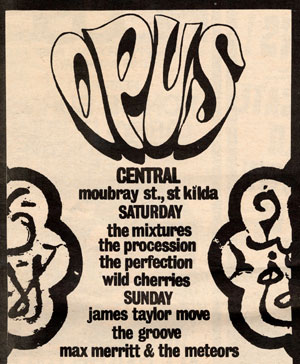 Throughout the summer, the group continued to play regularly on the Melbourne scene, appearing, for instance, at the Thumpin’ Tum on 6 June, the Catcher on 7 June (sharing the bill with the Master’s Apprentices and the Chelsea Set) and Berties on 10 June, alongside Max Merritt and the Compulsion.
Throughout the summer, the group continued to play regularly on the Melbourne scene, appearing, for instance, at the Thumpin’ Tum on 6 June, the Catcher on 7 June (sharing the bill with the Master’s Apprentices and the Chelsea Set) and Berties on 10 June, alongside Max Merritt and the Compulsion.
Eager to progress artistically, the Wild Cherries returned to the studios in the summer to record perhaps their most ambitious material to date. The fruits of the sessions were issued in September on what would become the group’s final single, “I Don’t Care” c/w “Theme for a Merry Go Round”. As a departure in sound from the previous releases, “I Don’t Care” took a “wall of sound” approach, complete with echo effects and an ambitious string arrangement that was charted by Robinson. “Theme for a Merry Go Round” meanwhile, with its jazzy slant, featured another superb Robinson vocal.
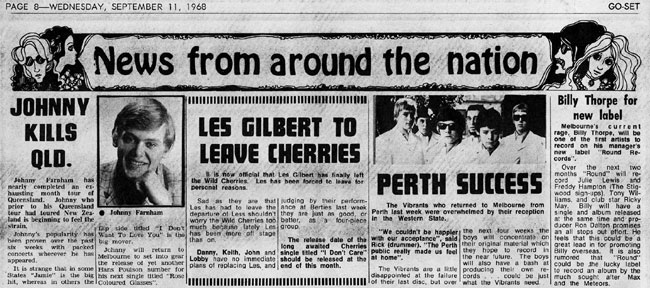
“I Don’t Care” may have been the group’s crowning achievement on a creative level, but as the single reached the shops, the group faced a mass exodus. The first to leave was Les Gilbert in late August.
“…After a while I started to lose interest,” admits the keyboard player. “We were working very hard, playing the same songs each night and a lot of the spontaneity of the earlier iterations of the band had gone. It really seemed to me to become a repetition of the same thing night after night and for this and other reasons I finally left. I completely left the scene and went to live in the hills with a wife and new baby (at the ripe old age of 22!).”
While the remaining quartet stuck together to play a few live shows, including one at Berties in early September, Keith Barber, Dan Robinson and John Phillips all departed soon after Gilbert. “As much as I enjoyed the Wild Cherries, I always thought more commitment could have been given to the stage craft,” reflects Barber.
Recalling the events leading up to his exit, Barber remembers travelling to a show in Sydney with New Zealand bands, the La De Das and Max Merritt & the Meteors. “I ended up in the audience with a guy called John ‘Yuk’ Harrison, who was the bass player in Max Merritt’s band. We were sitting there watching the La De Das and he said, ‘what do you think’ and I said, ‘I reckon they’re great’. He nudged me in the side and said, ‘you could be playing drums with that band if you want to’. I didn’t think anything more of it, but went back to the hotel where all the bands were staying in King’s Cross. One morning the La De Das walked in minus their drummer and asked me if I’d like to join. I had a sense that the Cherries were fragmenting and that I wasn’t going to cause the split by leaving… I really admired the La De Das, so I accepted the offer.”
The La De Das travelled to the UK in April 1969, but the trip was an unmitigated disaster. “We got involved with Peter Grant of Led Zeppelin…but he was just ripping us off,” says Barber. “He was taking Led Zeppelin’s equipment that was warehoused and making out that he was helping us out but in fact the La De Das were paying through the teeth [sic] for this equipment.”
The group ended up on Parlophone Records where it recorded a version of the Beatles’ “Come Together”, credited to the La De Da Band. Says Barber: “We were given all of the Abbey Road songs before they were released and told that we could record one of these songs. We listened to the whole album and the only thing we could see the way clear to making a decent single out of was ‘Come Together’. We recorded at Abbey Road and then went on a tour of France.”
“Come Together” failed to dent the charts and shortly afterwards the group unravelled with most members returning to Australia. Barber continued to play with the La De Das until 1975 before dropping out of the music scene.

Robinson meanwhile accepted a job with the vocal trio, the Virgil Brothers, replacing former Wild Cherries and Python Lee Jackson member Malcolm McGee. “The story of my life, at least for my first few years in the rock music industry, was I got offered jobs and I just jumped aboard without thinking about it too much,” says Robinson. “The Cherries had done their dash and even at the time, it wasn’t much of a dash.”

The Virgil Brothers, who featured yet another former Wild Cherry and ex-Loved Ones, Rob Lovett alongside singer Peter Doyle, also moved to England where they worked with Peter Gormley Associates and were managed by Bruce Welch of the Shadows. Robinson subsequently sang on the UK (and re-recorded) version of the Virgil Brothers’ debut Australian single, “Temptation’s About To Get Me”, and its follow up, “When You Walk Away” but found the whole experience a huge disappointment.
From the outset, there was a complete mismatch in terms of what the trio and EMI expected from the project on a musical level. Comprised of “R&B freaks”, the group had little input or say in the material that was recorded; the Eurovision-type songs EMI foisted on the band were chosen by the A&R men and as Robinson concedes, the trio was not passionate about this. It also didn’t help that the whole set up bore an uncomfortably close resemblance to the far more successful Walker Brothers. After passing on an offer to join the New Seekers (Peter Doyle took his place), Robinson returned to Australia in 1970.
Back in Melbourne, Robinson went to university and studied for a Bachelor in Music, majoring in composition. During the ‘70s, he played and recorded with a succession of groups, including Duck, Hit and Run, Champions and Rite on the Nite. Teaching himself wood skills in the ‘80s, Robinson moved to northwest Tasmania where he eventually established his own business as a novel musical instrument maker. He continues to perform occasionally and is currently based in Anakie, Victoria.
In October 1968, Loyde recruited new singer Matt Taylor from local band, the Bay City Union and three former members of Brisbane blues group, Thursday’s Children, but the soul of the group had effectively been ripped out. The following month, Loyde handed in his notice.
He landed on his feet immediately and was instrumental in reviving Billy Thorpe’s career, teaching the Australian rock legend how to play rock ‘n’ roll guitar and becoming an integral member of Thorpe’s highly touted Aztecs between 1968-1970.
The Wild Cherries soldiered on, but effectively it was another group in everything but name. Bedevilled by a succession of personnel changes, the band finally imploded in April 1969. Interestingly, Loyde chose to resurrect the Wild Cherries’ name with new musicians in 1971, but the line up’s lone single, the heavy rock extravaganza, “I Am the Sea”, bore no resemblance to the four classic singles issued between 1967-1968.
Throughout the ‘70s, Loyde pursued a series of intriguing projects. In 1971, he recorded his debut solo album, Plays With George Guitar, which Ian McFarlane describes as “a progressive rock milestone, one of the most remarkable heavy guitar records of the period.” He then recorded three albums with the highly revered Coloured Balls, which was followed by a second solo set, Obsecration, in 1976.
Loyde next travelled to the UK and hung out and sat in on recording sessions with Siouxsie and the Banshees, among others. Returning to Australia in 1979, he joined Rose Tattoo on bass. The group relocated to Los Angeles to record an album, but it was never released. Back in Australia, he moved into production and live sound mixing but occasionally ventured back in to live work, most notably with the bands, Dirt and Fish Tree Mother. In October 2002, he was inducted into the Australian Blues Foundation Hall of Fame.
Of Loyde’s former colleagues, Peter Eddey currently manages postgraduate business programmes at Sydney’s Macquarie University. Despite leaving the music business in the ‘60s, Eddey plays a few gigs a month with a band.
The group’s founder, Les Gilbert, meanwhile, returned to university in 1975 to study music, majoring in composition. He then played on the city’s avant garde music scene until the early ‘80s. “I particularly became interested in making recordings of the natural environment and also in creating multi-media installations,” says Gilbert. “This gradually morphed into the work I do today with my partner, Gillian Chaplin. We have a company called Magian Design Studio and we create media installations for museums and other similar institutions.” Gilbert has created sound and multimedia installations for the Osaka Aquarium in Japan, the National Geographic Society in Washington DC and the Kakadu National Park, among others.
With each of the Wild Cherries forging careers in widely diverse areas, the group’s story could have ended there. However, the legend surrounding the band has grown over the years and for Australia Day 2002, a special one-off reunion show was put on at the Corner Hotel in Richmond, Victoria, featuring Dan Robinson, Lobby Loyde and Keith Barber, abetted by bass player Gavin Carroll and keyboard player John O’Brien. Les Gilbert was unable to make the date, as he was working in Japan.
For the occasion, the Wild Cherries performed all eight of the group’s recordings –not only the first time that all of the band’s recordings had been performed live but also the first time that some of the tracks had been given a public airing. The Cherries’ set was recorded for posterity but despite the stellar performances, Robinson has mixed feelings about the event. “The concert was appallingly marketed, they could have done a lot more. We had a large, very enthusiastic crowd but it could have been huge. It was about as badly managed as the Wild Cherries had been back in their heyday.”
In spite of the warm reception, Robinson also has his doubts regarding any future reunions. “They came up with the notion of doing it again the following year, but Keith decided that doing it once was enough and that if he did anything at all, he’d rather do something new, and I think I went along with that.”
The prospect of any future reunions was dealt a cruel blow when Keith Barber sadly passed away on 30 May 2005. The timing of his death is particularly poignant as Australia collectors’ label Half a Cow Records was in the process of putting together the first ever compilation of the band’s work, which finally emerged in April 2007. Its release coincided with the death of another Wild Cherry, Lobby Loyde on 21 April.
Perhaps if the group had got the opportunity to record an album during its heyday things would have been different but as Robinson points out, “We were considered to be too uncommercial by the record company at the time. We were just totally out of step with the people who ‘called the shots’ commercially.”
Loyde agrees: “It was pretty hard in our day because we were way more experimental and way more psychedelic and we had to condense it down and knock it out on a few singles… I wish we could have recorded it live because it used to go to some really strange places. We could play three or four hours and knock over eight or 10 tunes. It was quite exotic live. It would have just been great to have made an album because people talk about how great it was being there. Trouble is when you are there and it’s happening, you just wish someone had documented it because it was pretty exciting live.”
Robinson, however, remains philosophical about the band’s legendary status. “There seems to be this feeling that we were musically important but at the time we didn’t seem to be a hell of a lot more than just a Melbourne club band. That’s the way I saw it. I never regarded us as being part of a national pop scene. Like all legendary things it’s a lot bigger in retrospect than it was at the time.”
Thanks to the following people for their generous help Keith Barber, Peter Eddey, Les Gilbert, Lobby Loyde, Dan Robinson, Glenn A Baker, Peter Culnane, Ian McFarlane, Mike Paxman and Ben Whitten.
The Wild Cherries CD can be purchased at www.halfacow.com.au.
E-mail: haclabel@mpx.com.au
If anyone would like to contact me with additions, clarifications or corrections, please e-mail: Warchive@aol.com.
Copyright © Nick Warburton. All Rights Reserved. No part of this article may be reproduced or transmitted in any from or by any means, without prior permission from the author.
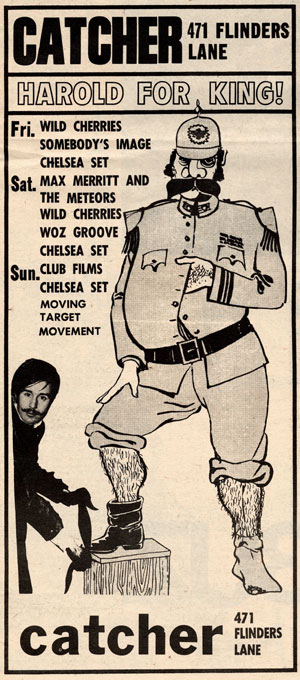


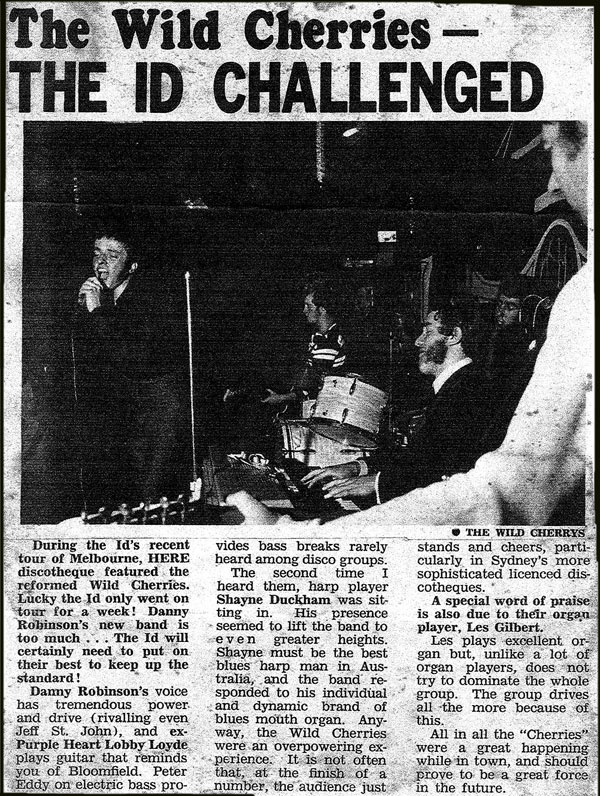
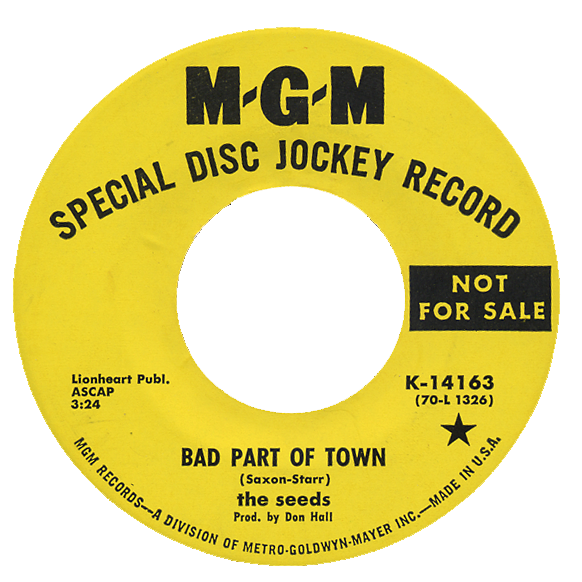
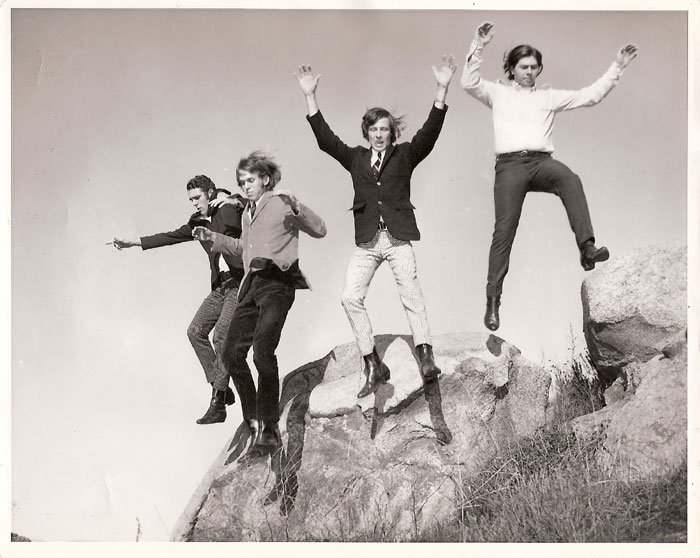
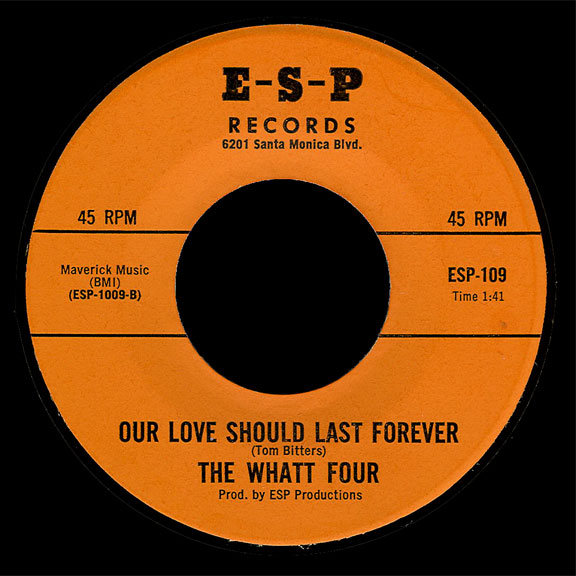
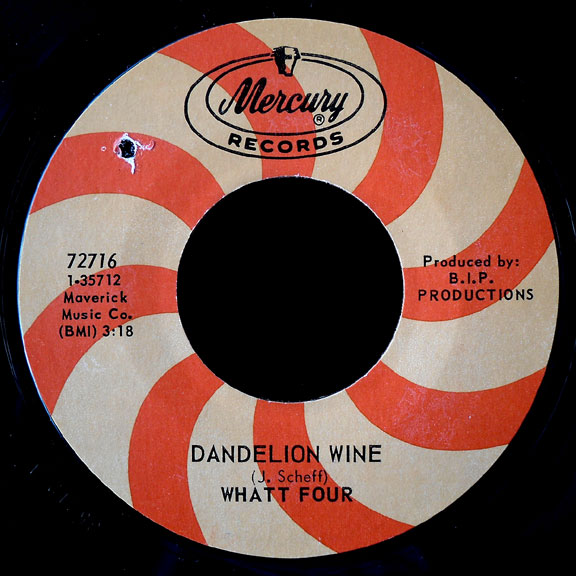
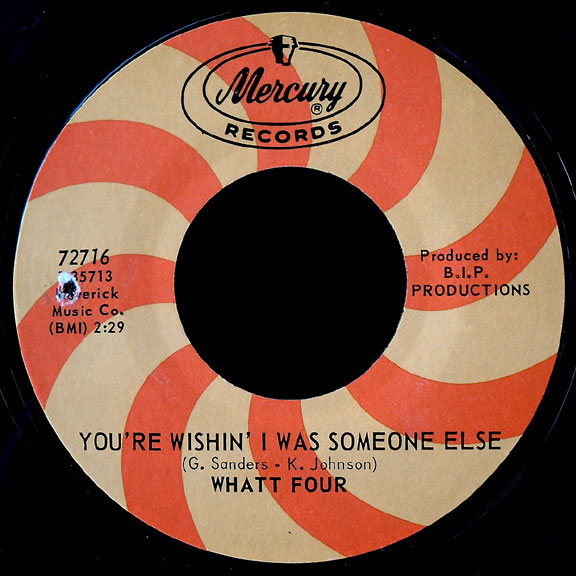
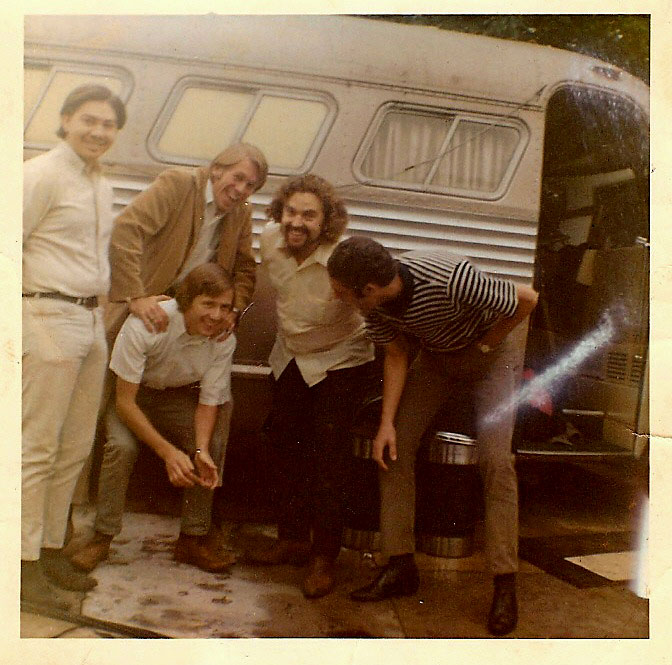

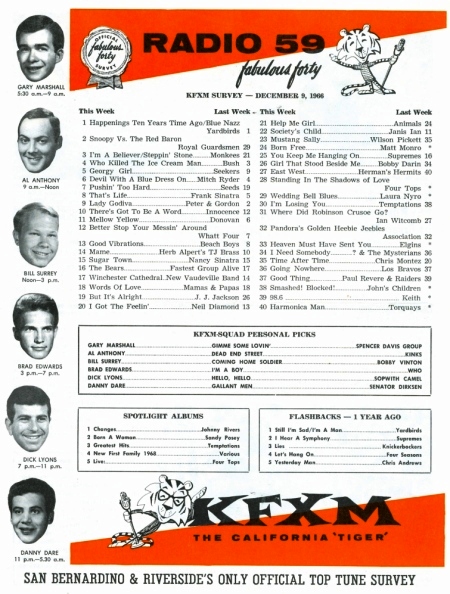
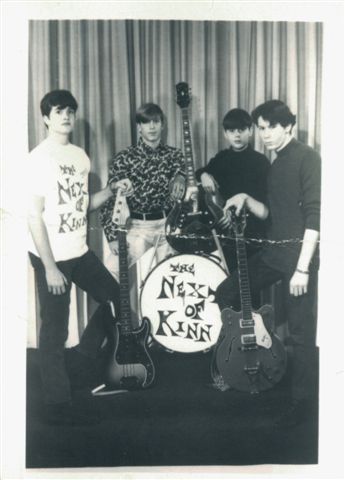

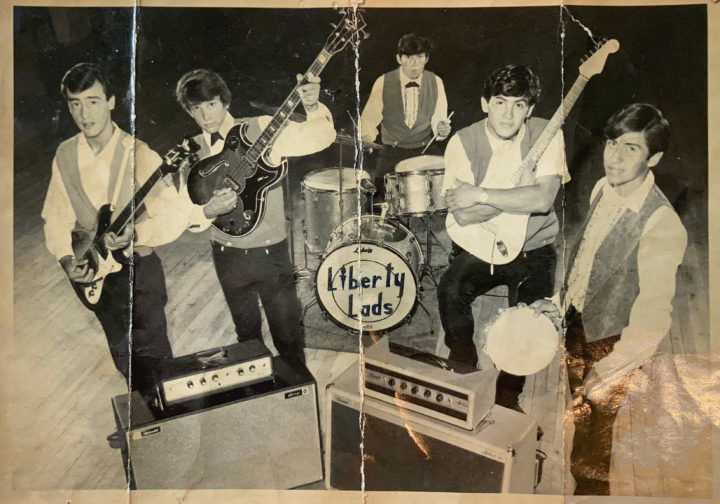
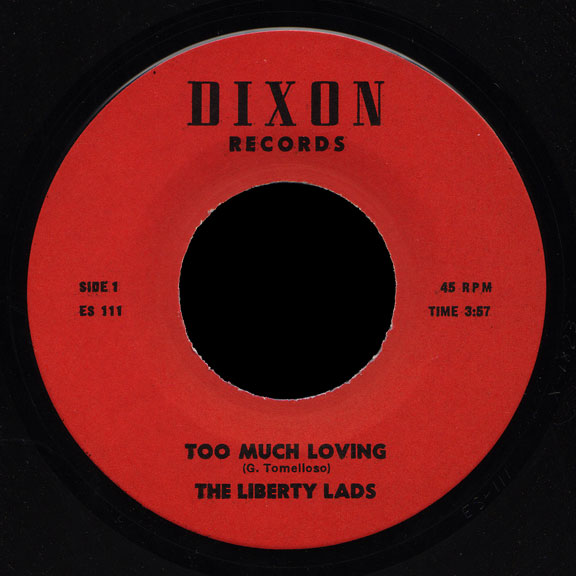 The Liberty Lads were from the Liberty Farms and Dixon area east of Vacaville. In 1965, like many bands from the area, they recorded at Bill Rase’s studio on Franklin Blvd in Sacramento, a package deal of a few hours recording time and 45s on a custom label to sell at their shows.
The Liberty Lads were from the Liberty Farms and Dixon area east of Vacaville. In 1965, like many bands from the area, they recorded at Bill Rase’s studio on Franklin Blvd in Sacramento, a package deal of a few hours recording time and 45s on a custom label to sell at their shows.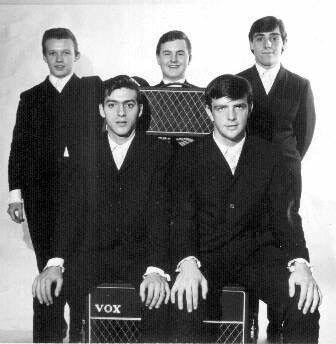
 From the Bronx, the Elegant Four were also known as the Elegants. Tom Crosgrove was lead guitarist and vocalist, and wrote both songs on their only 45. Other members included Bill Dennis and Pete Santora.
From the Bronx, the Elegant Four were also known as the Elegants. Tom Crosgrove was lead guitarist and vocalist, and wrote both songs on their only 45. Other members included Bill Dennis and Pete Santora.
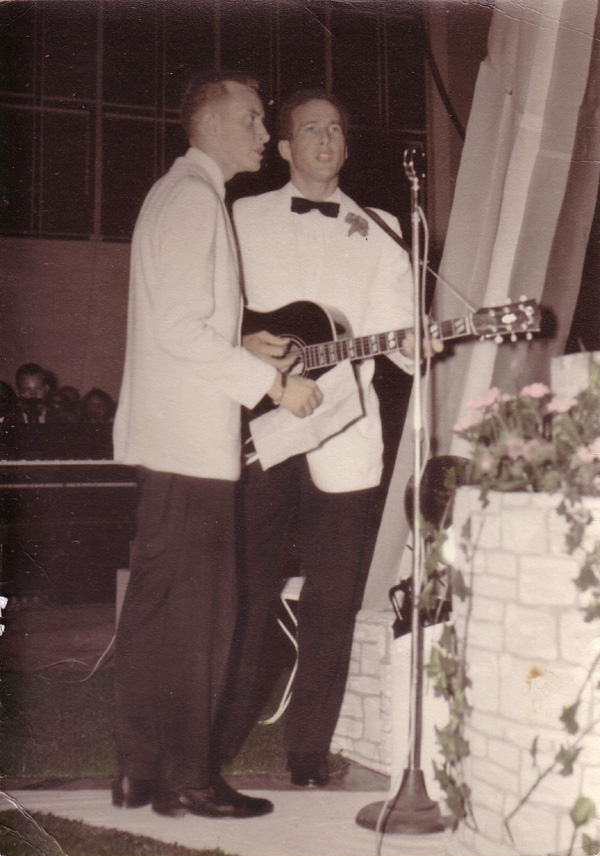
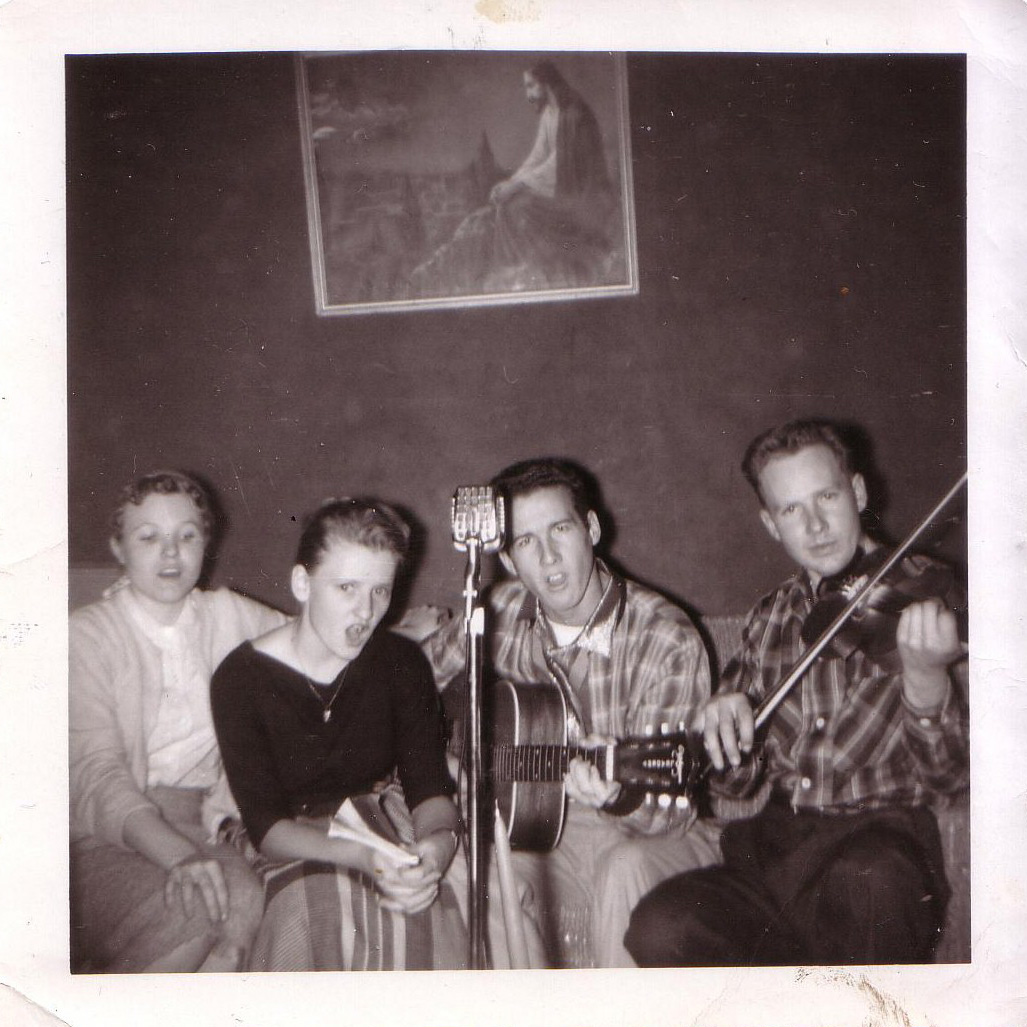
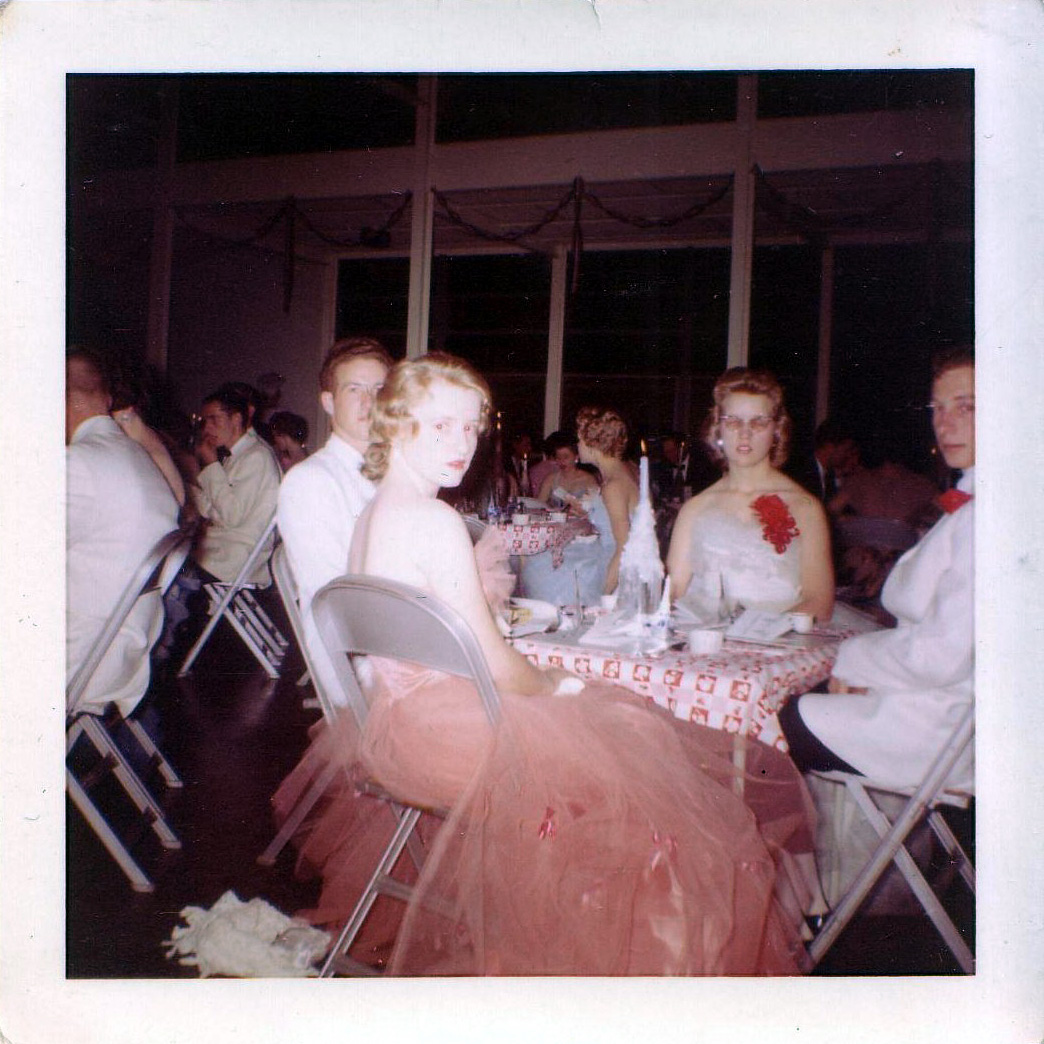

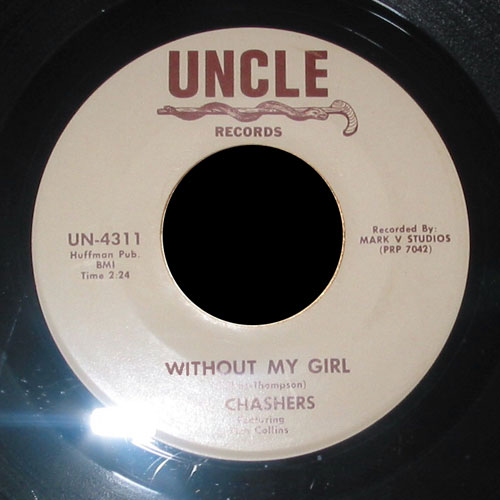 After a period of time, everyone went their separate ways. Soon after, Lamar and Roy Thompson collaborated and put their heart and soul into two songs “The Wind” and “Without My Girl”.
After a period of time, everyone went their separate ways. Soon after, Lamar and Roy Thompson collaborated and put their heart and soul into two songs “The Wind” and “Without My Girl”.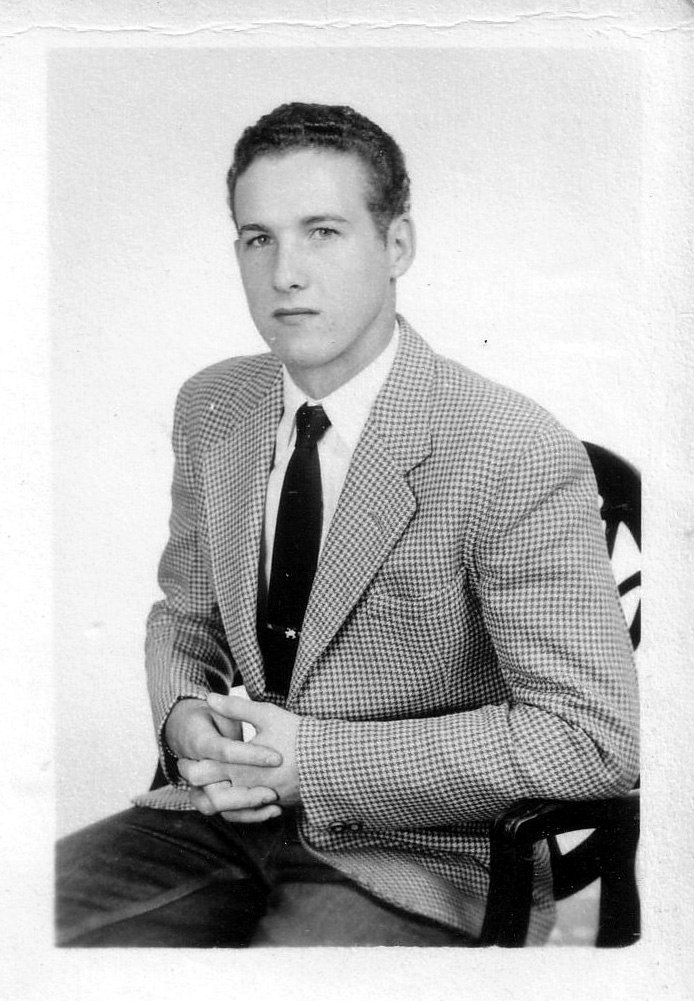

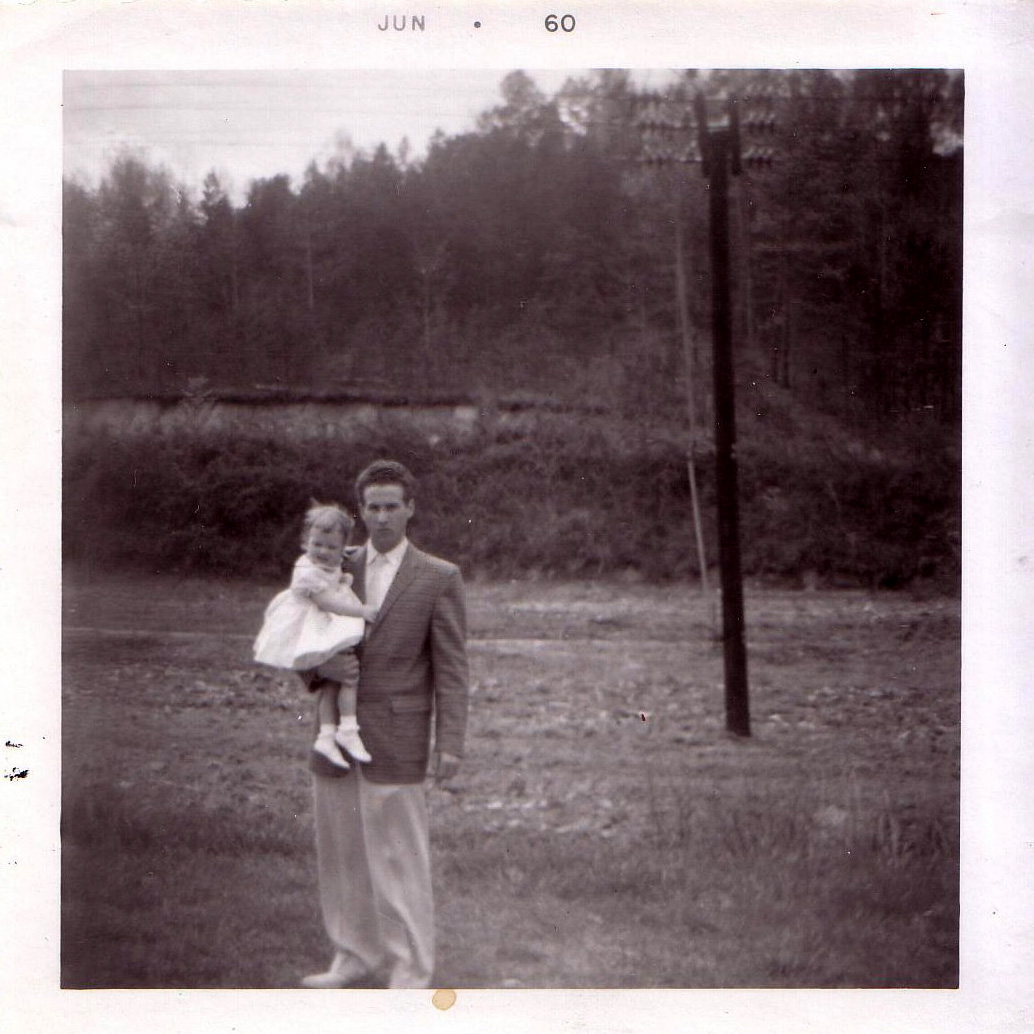
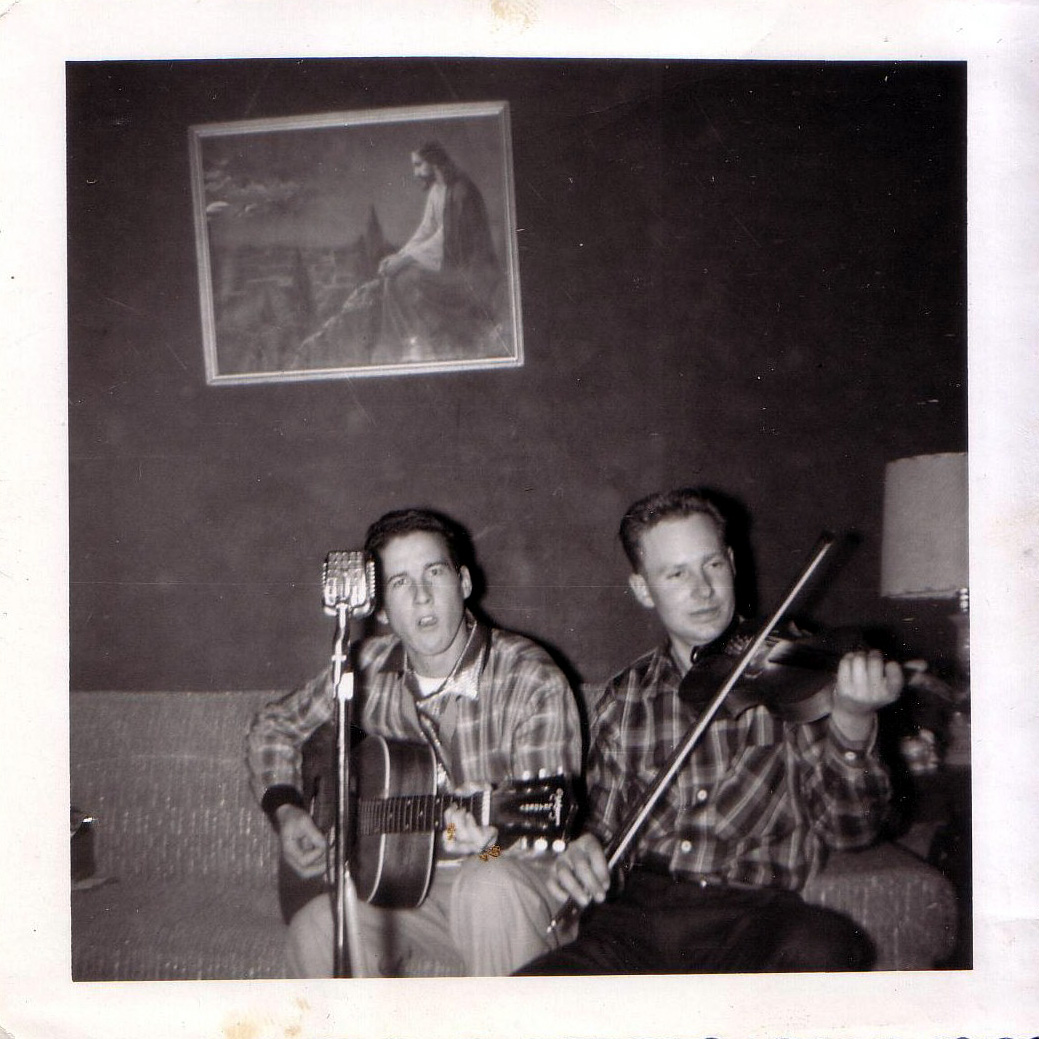
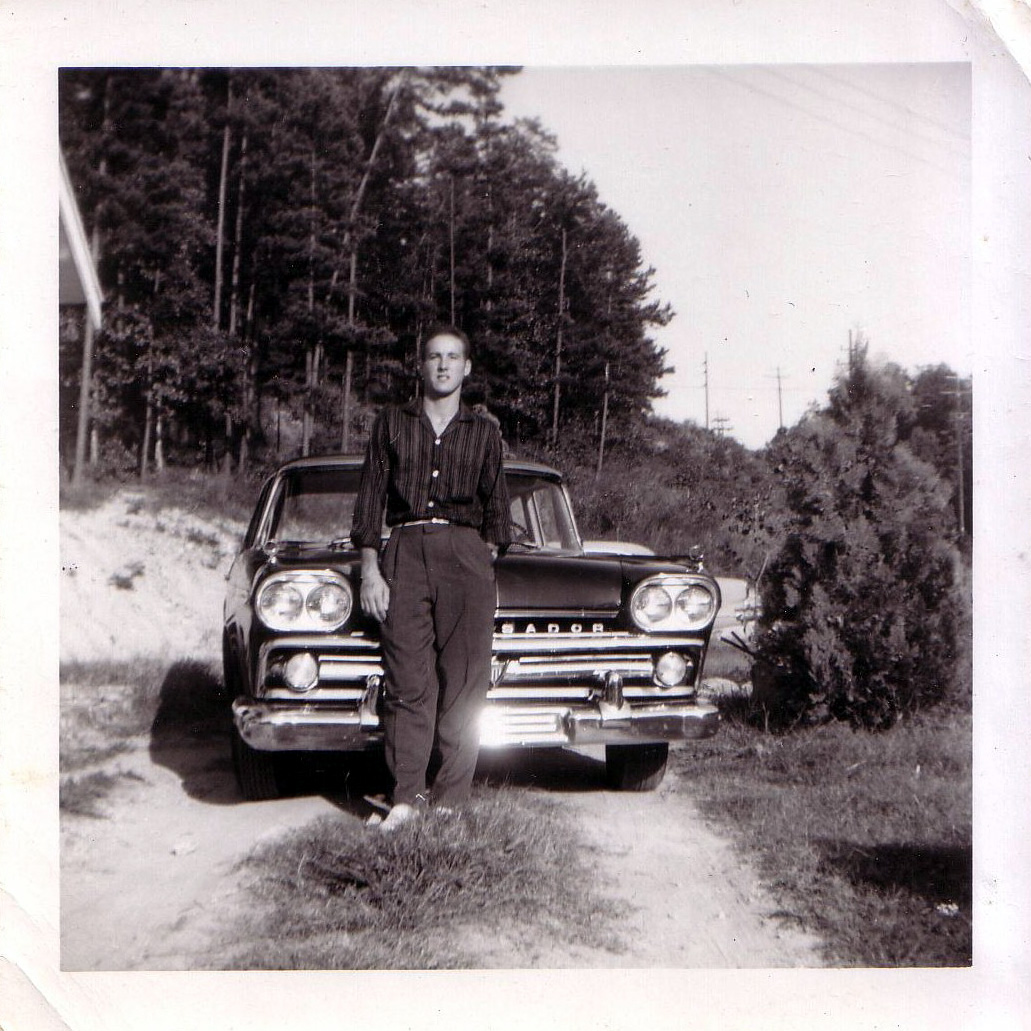
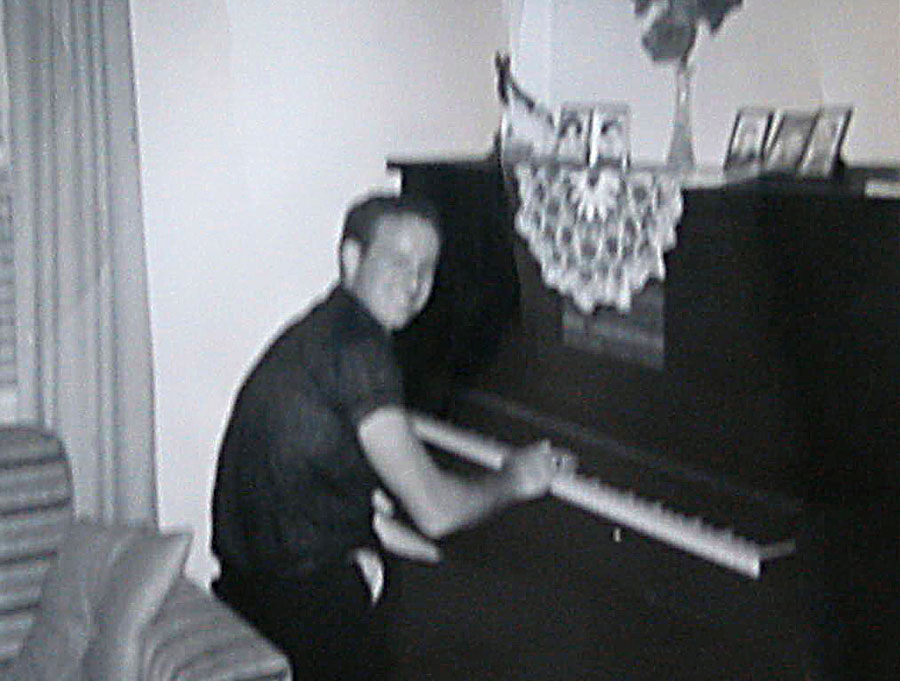
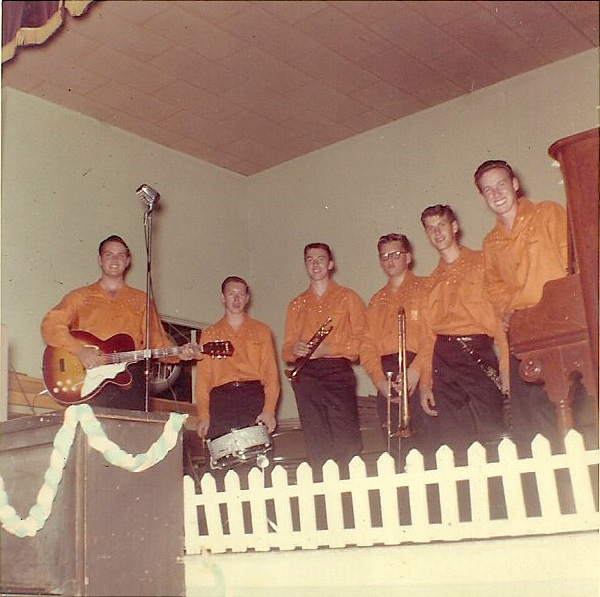
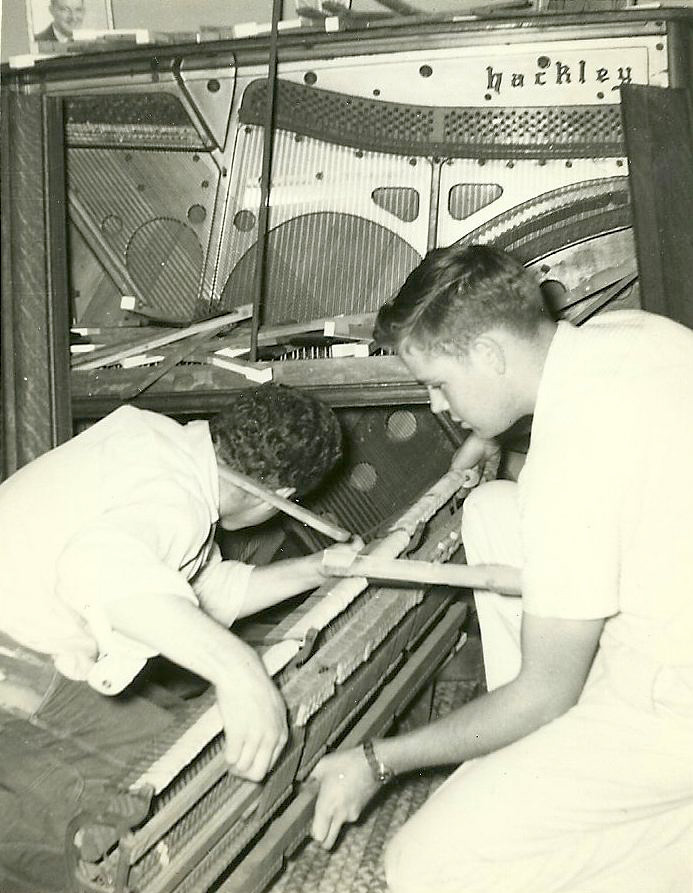
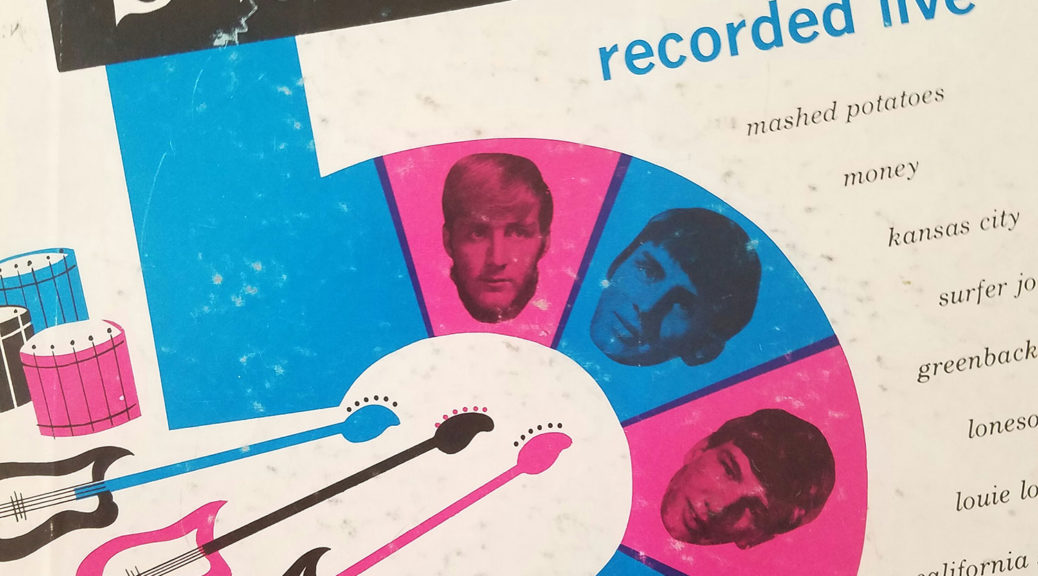
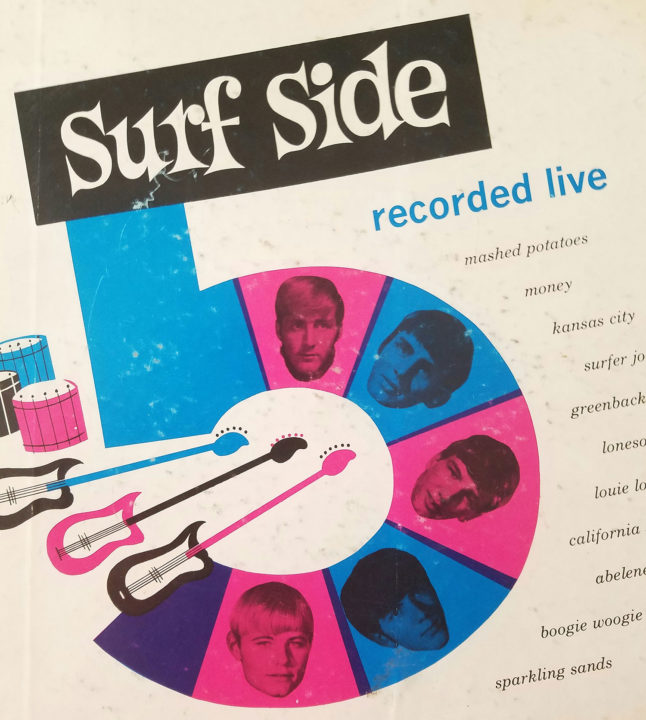
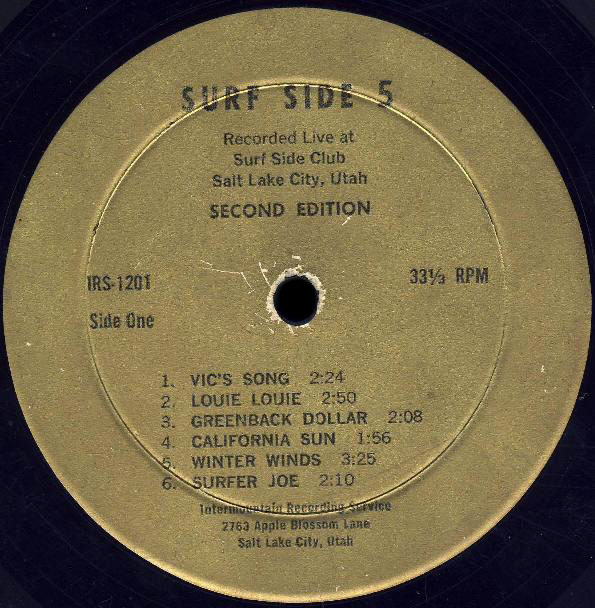 Steve Carter of Phoenix rescued this very rare LP by the Surf Side 5 from the trash, scanned the labels and transferred the LP to CD to share with Garage Hangover. Steve didn’t find the cover, and it wasn’t until August 2012 that Ed Nadorozny found the low-resolution photos of the front and back cover seen below.
Steve Carter of Phoenix rescued this very rare LP by the Surf Side 5 from the trash, scanned the labels and transferred the LP to CD to share with Garage Hangover. Steve didn’t find the cover, and it wasn’t until August 2012 that Ed Nadorozny found the low-resolution photos of the front and back cover seen below.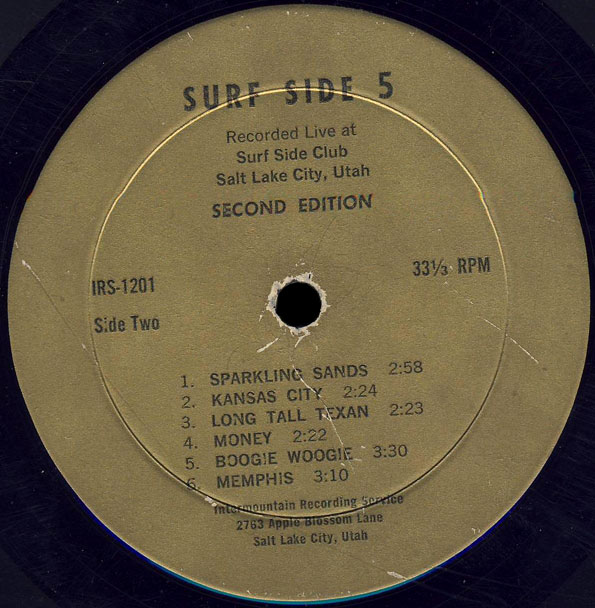 “Greenback Dollar”, “Louie Louie”, “Surfer Joe”, “Memphis” (the Lonnie Mack version), “Kansas City” (the Trini Lopez version) and “Long Tall Texan” were all hits of 1963, and “California Sun” hit big in early 1964, so I think it’s safe to date this to very early ’64. Certainly there’s zero British Invasion influence in their choice of material or style.
“Greenback Dollar”, “Louie Louie”, “Surfer Joe”, “Memphis” (the Lonnie Mack version), “Kansas City” (the Trini Lopez version) and “Long Tall Texan” were all hits of 1963, and “California Sun” hit big in early 1964, so I think it’s safe to date this to very early ’64. Certainly there’s zero British Invasion influence in their choice of material or style.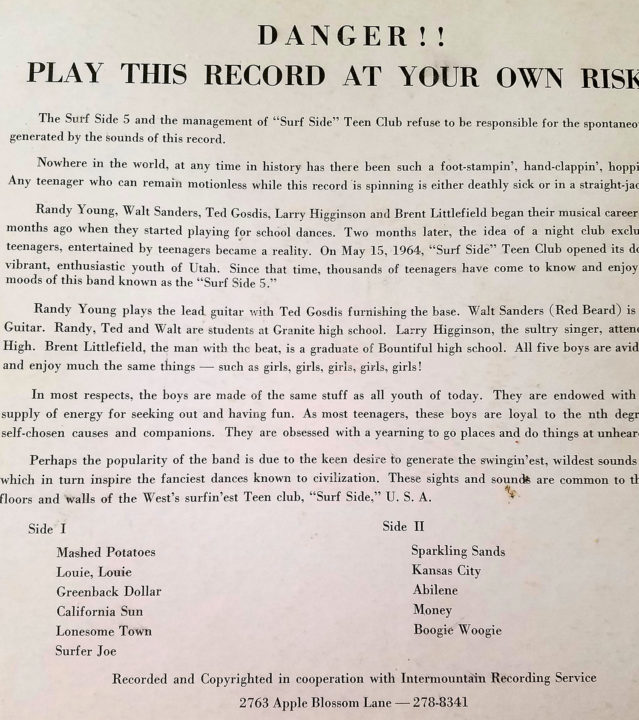
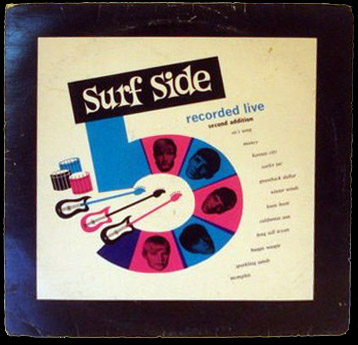
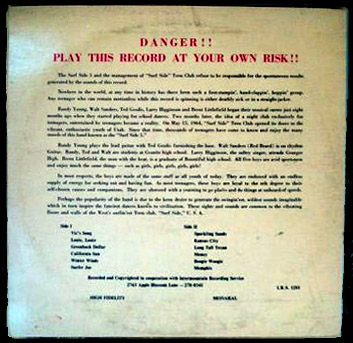
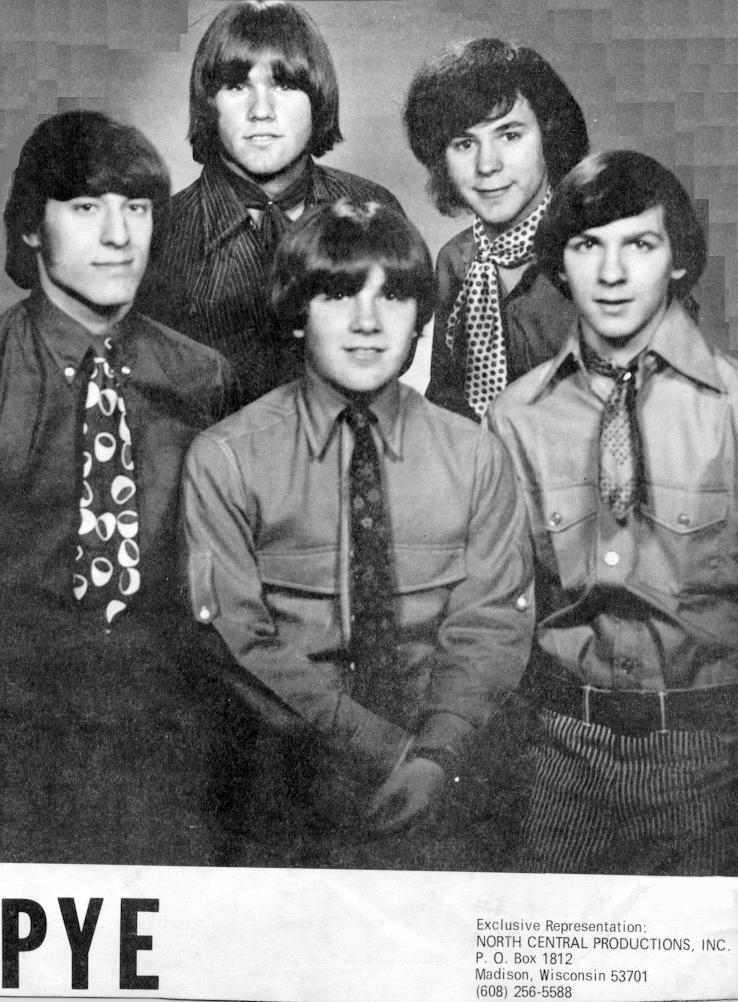
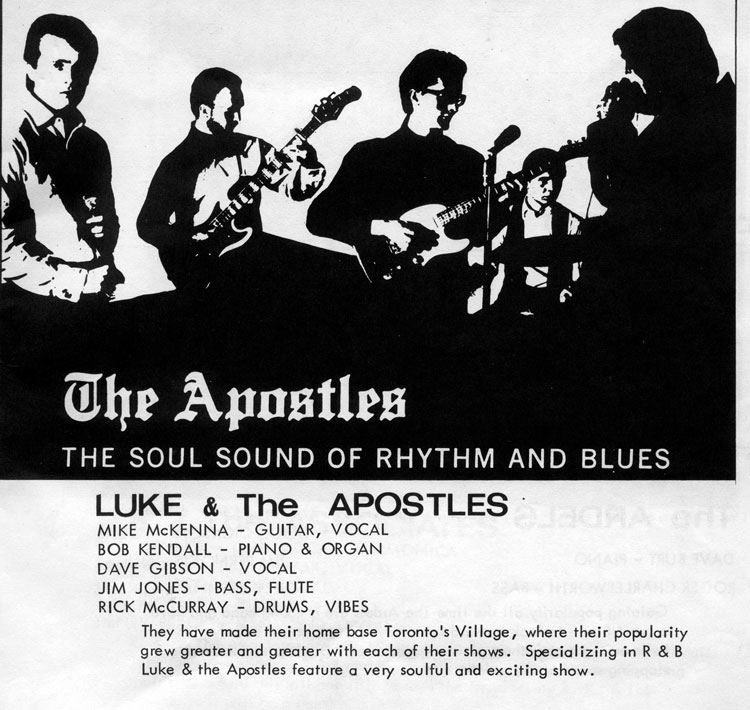


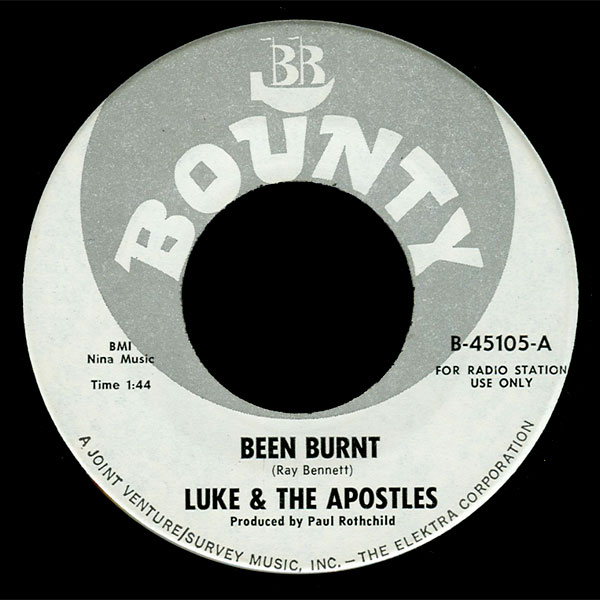
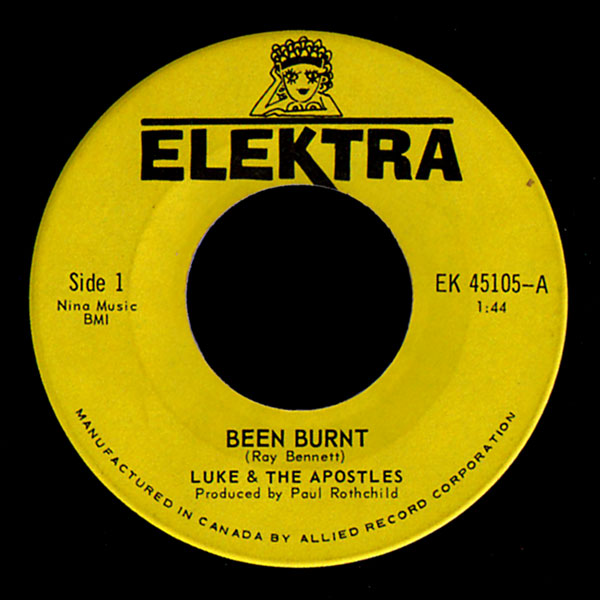 Undeterred, Luke & The Apostles resumed gigging in Toronto and began to extend their fan base beyond Yorkville Village, performing at venues like the North Toronto Memorial Arena on 28 May. But uncertainty over the single’s release and the band’s long-term future began to take its toll, and in early summer Jim Jones announced that he was leaving because he wanted to give up playing. Former Simon Caine & The Catch bass player Dennis Pendrith (b. 13 September 1949, Toronto), who was still in high school at the time, had the unenviable task of filling his idol’s shoes.
Undeterred, Luke & The Apostles resumed gigging in Toronto and began to extend their fan base beyond Yorkville Village, performing at venues like the North Toronto Memorial Arena on 28 May. But uncertainty over the single’s release and the band’s long-term future began to take its toll, and in early summer Jim Jones announced that he was leaving because he wanted to give up playing. Former Simon Caine & The Catch bass player Dennis Pendrith (b. 13 September 1949, Toronto), who was still in high school at the time, had the unenviable task of filling his idol’s shoes.